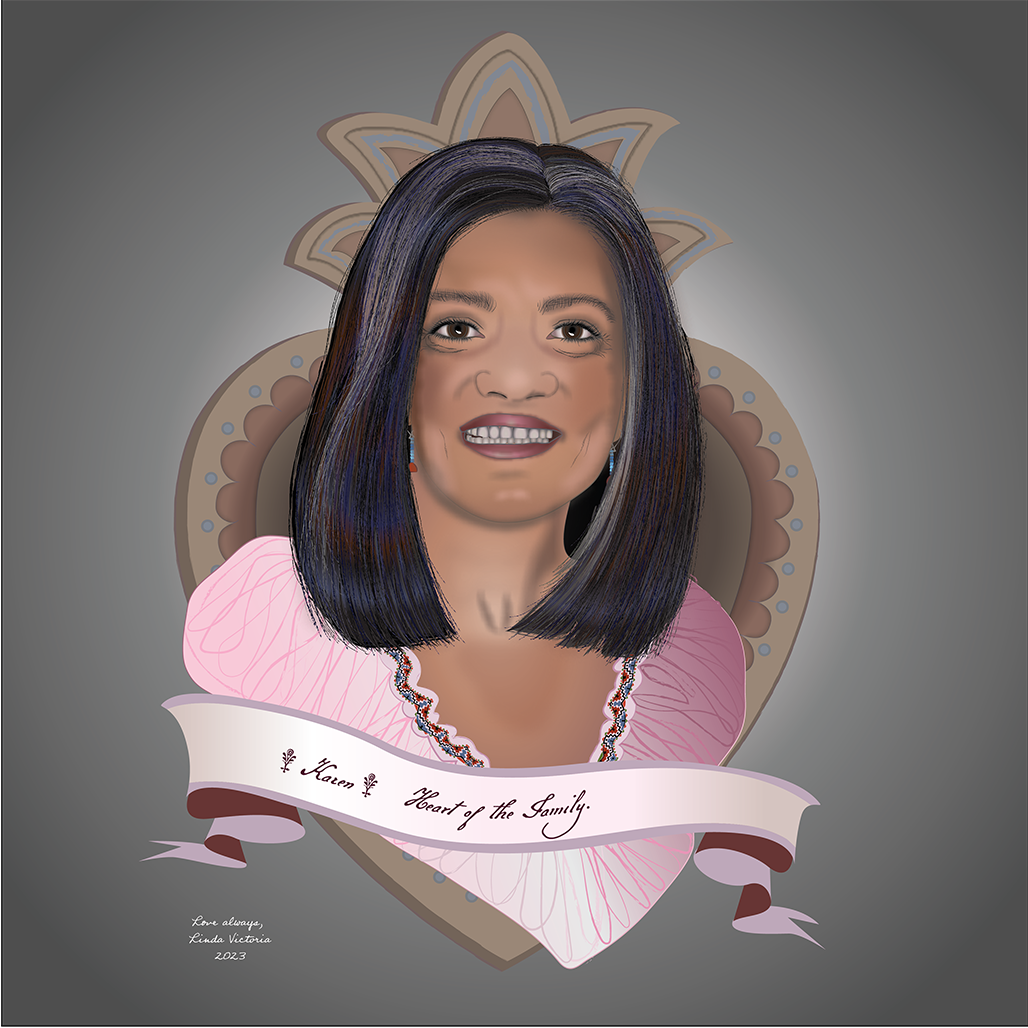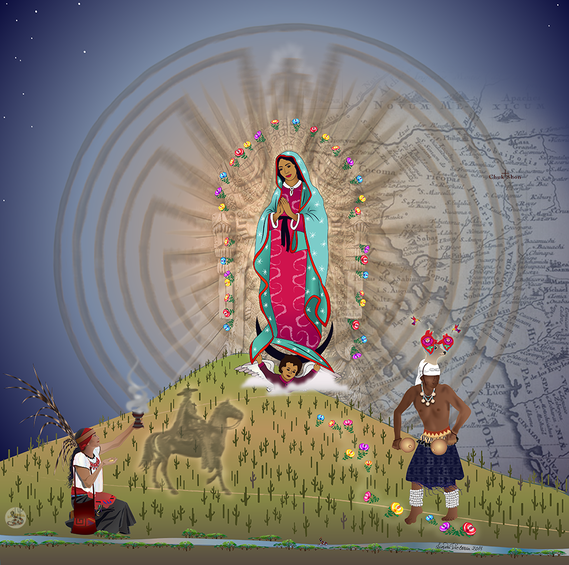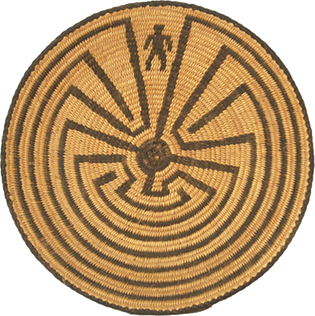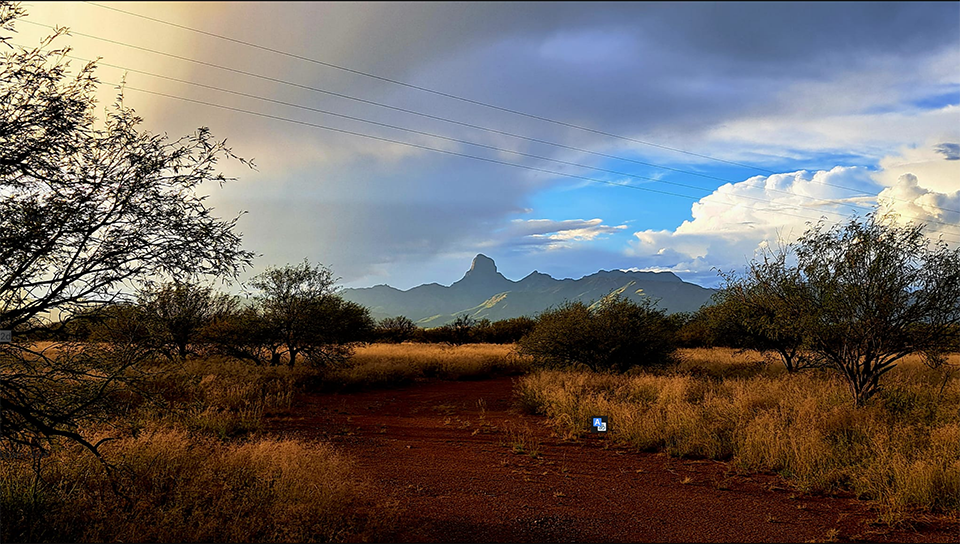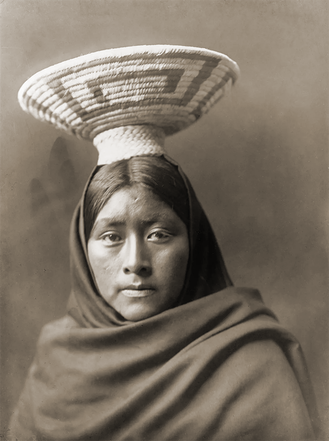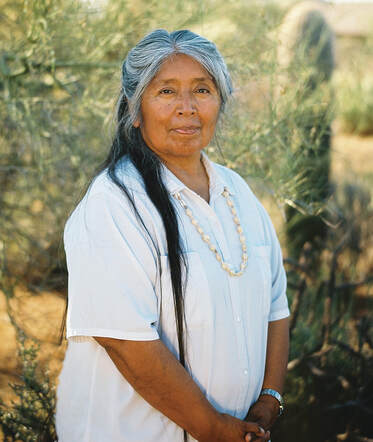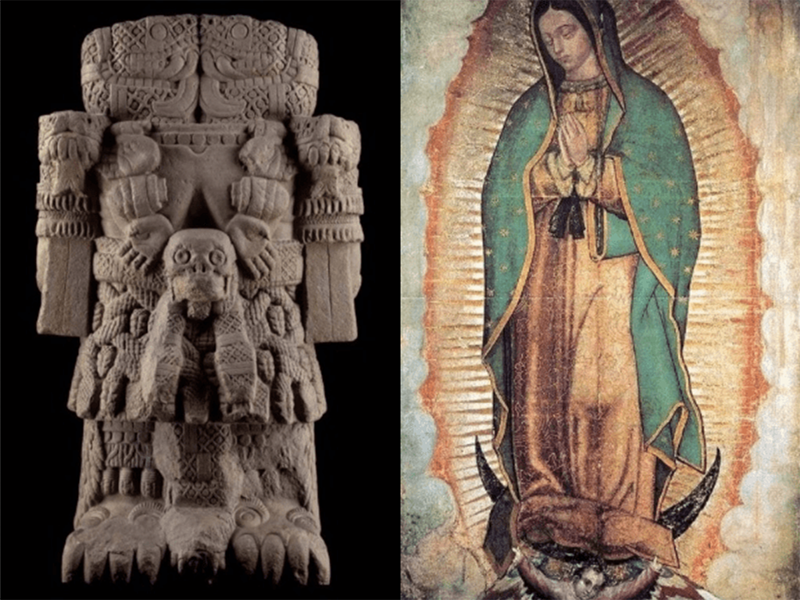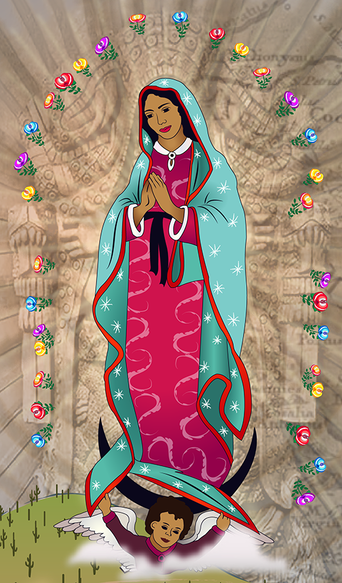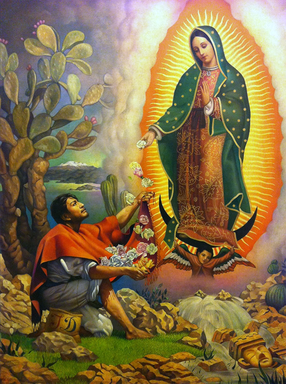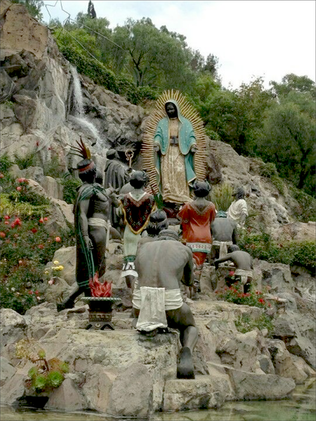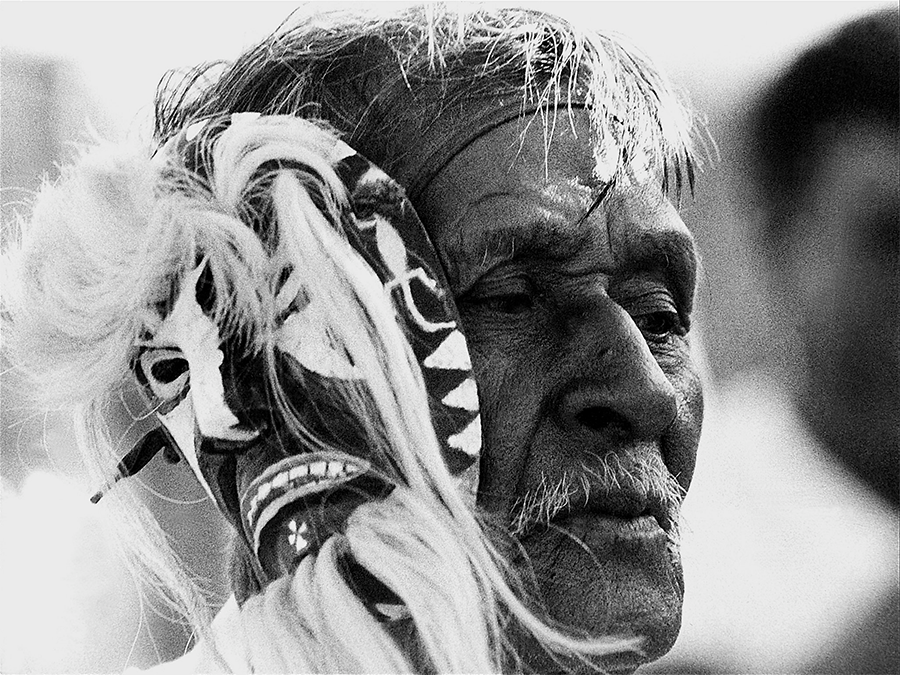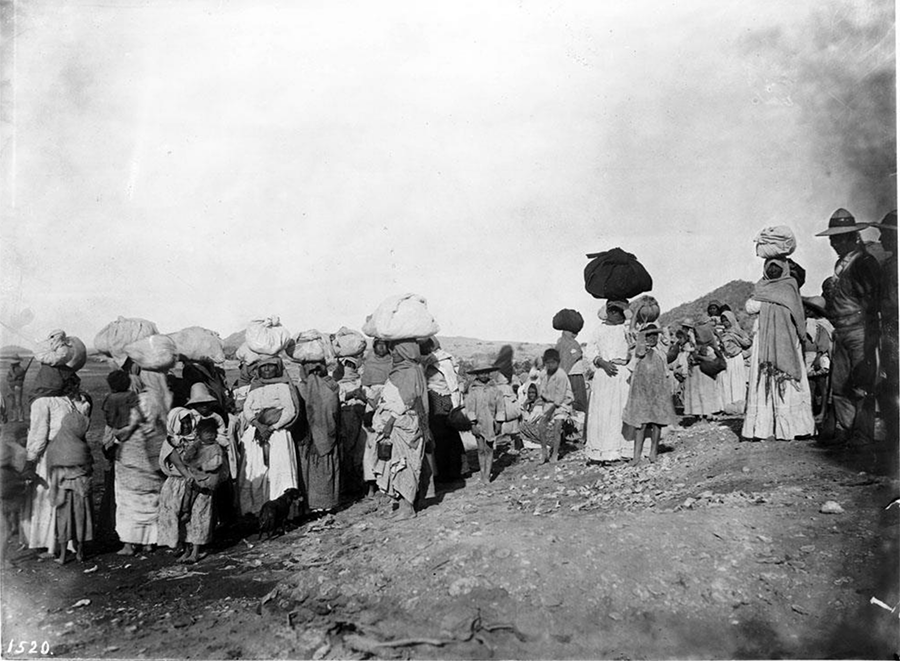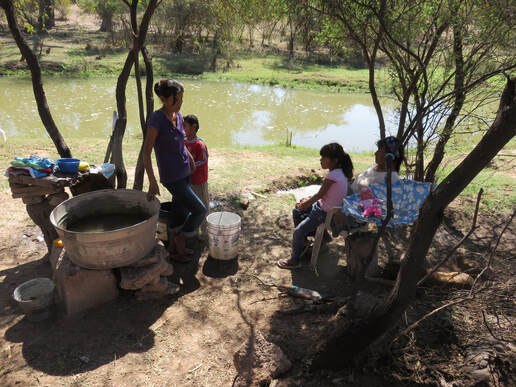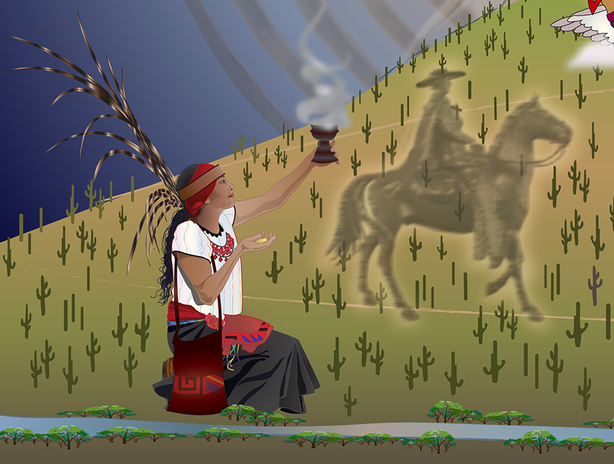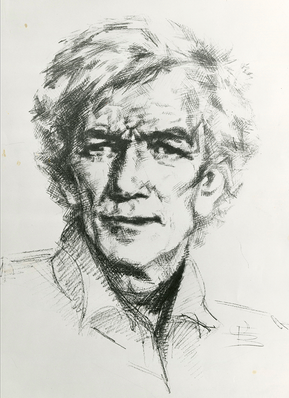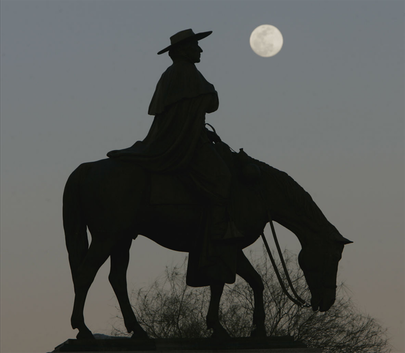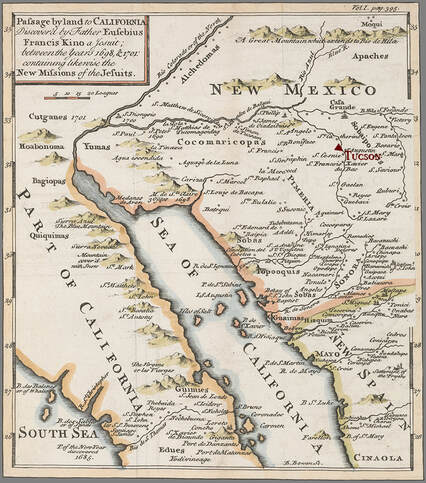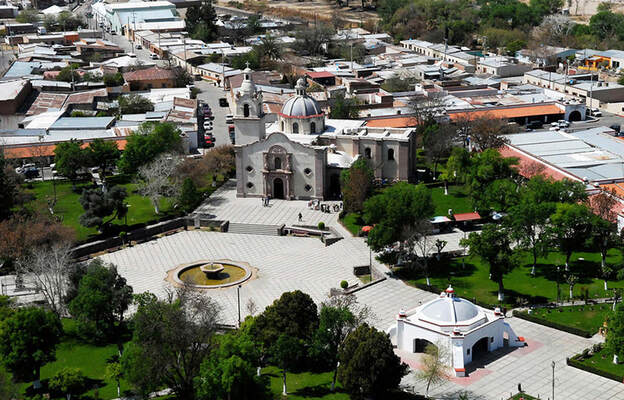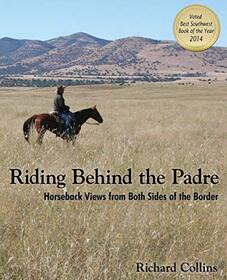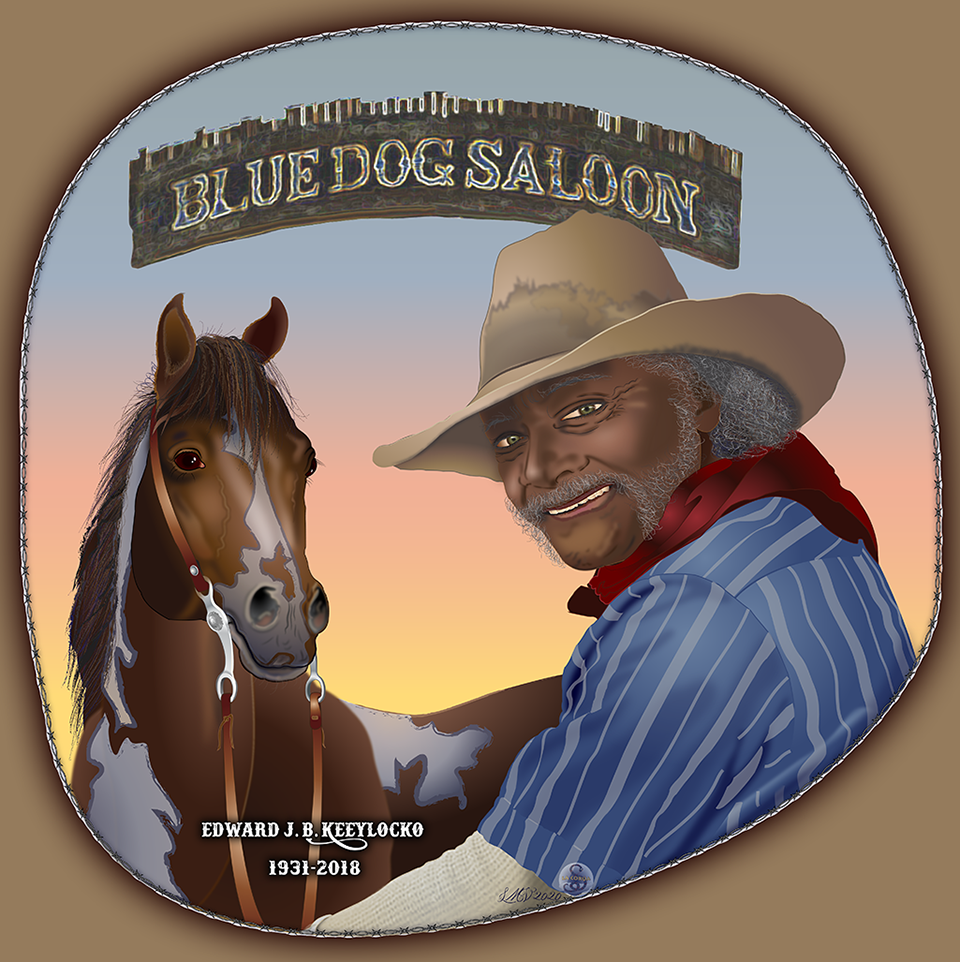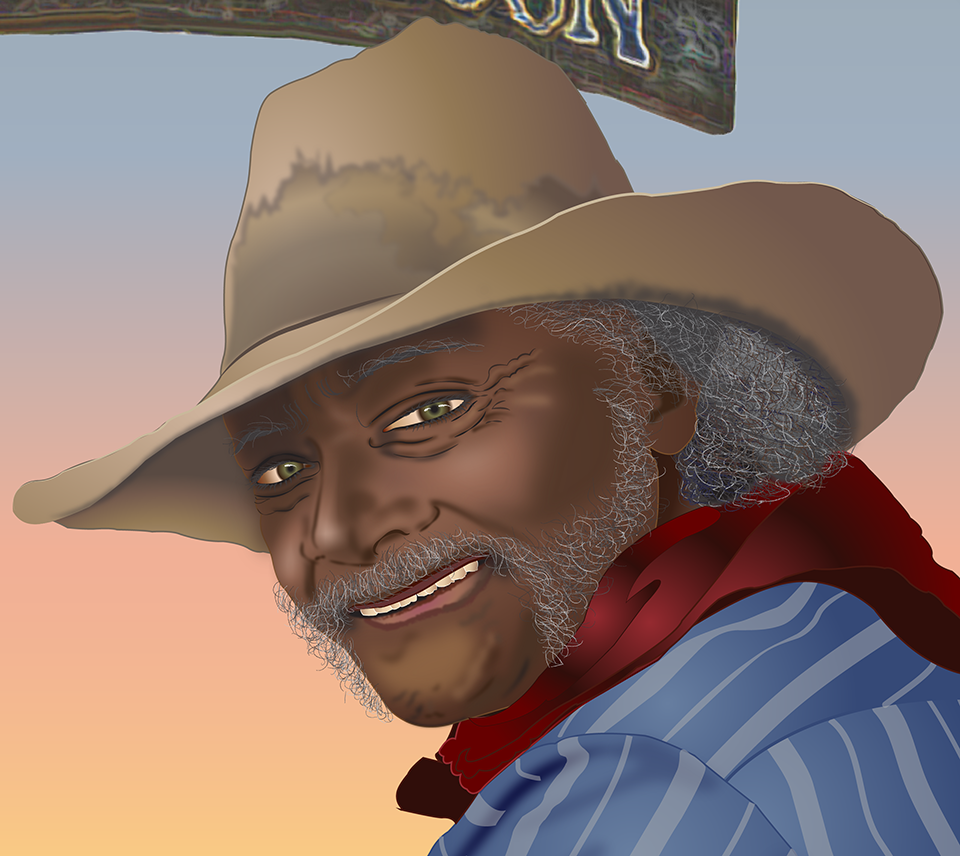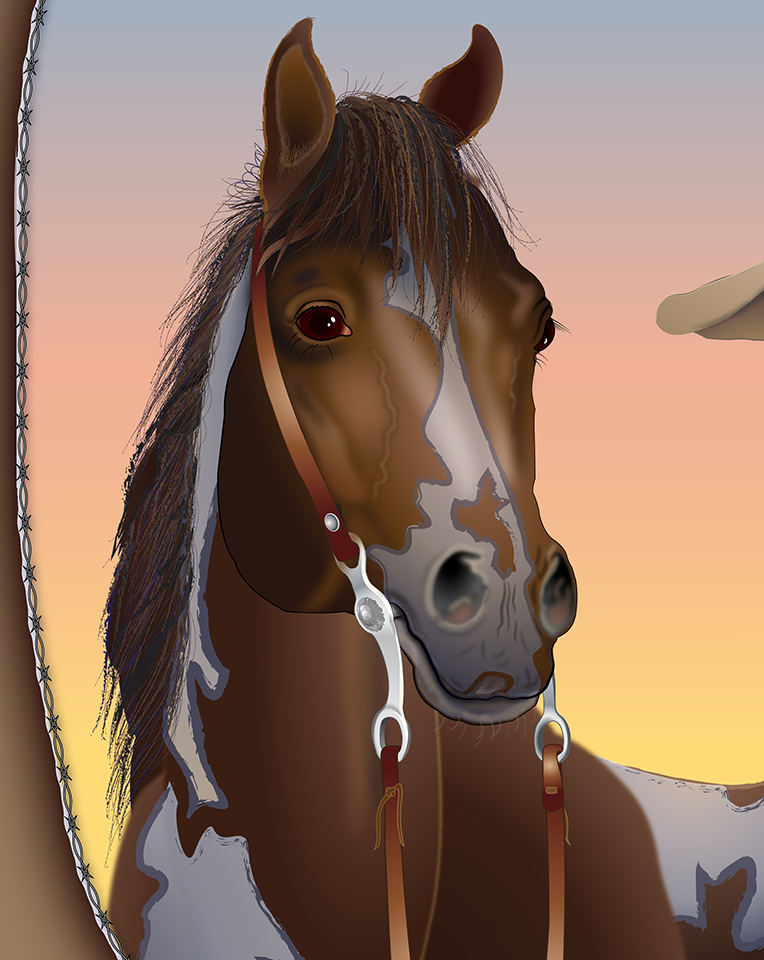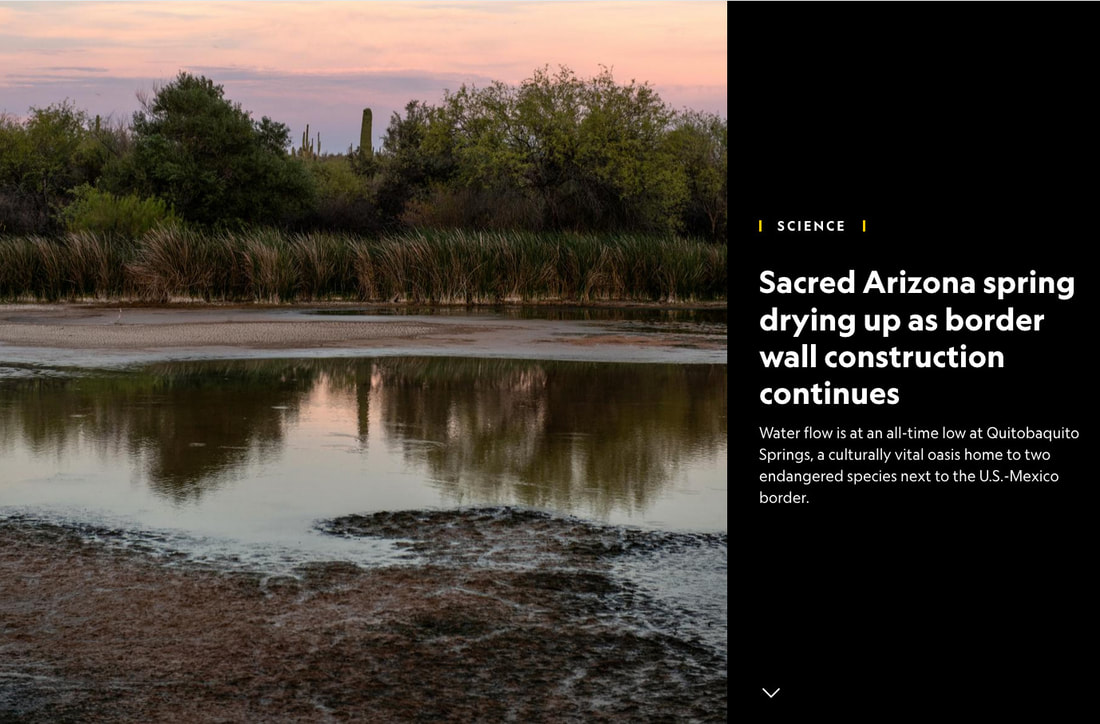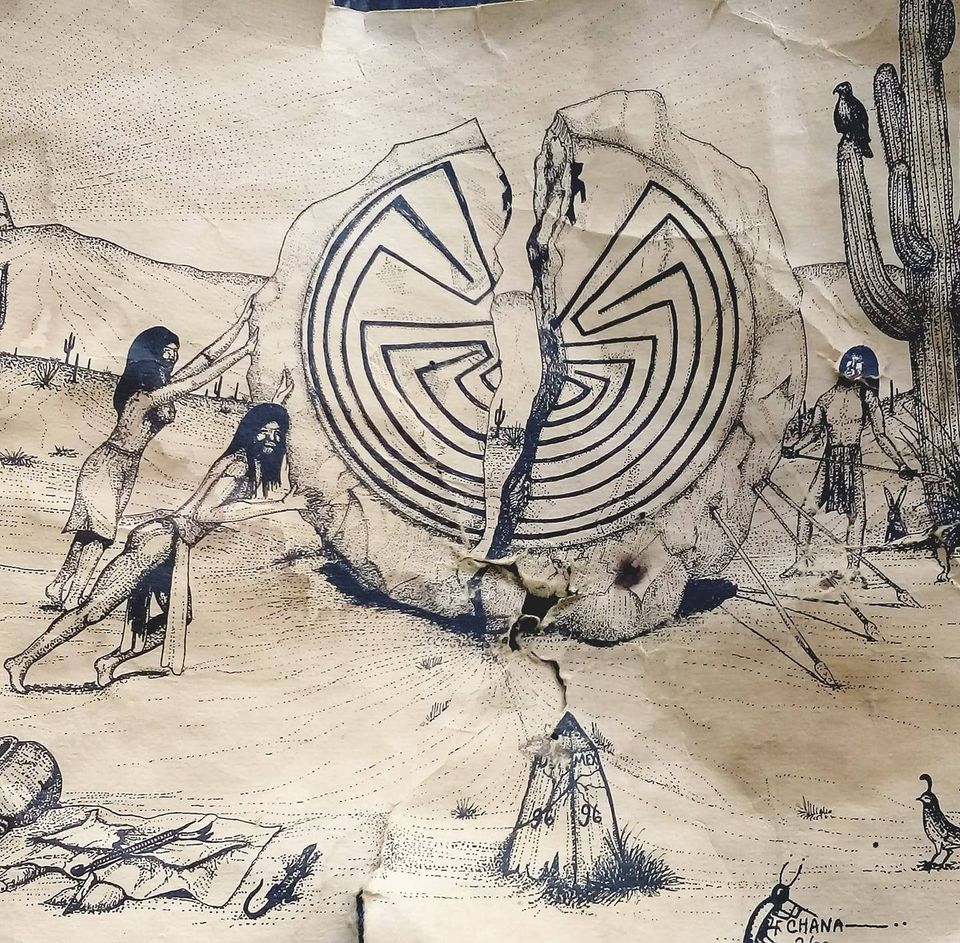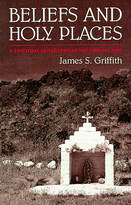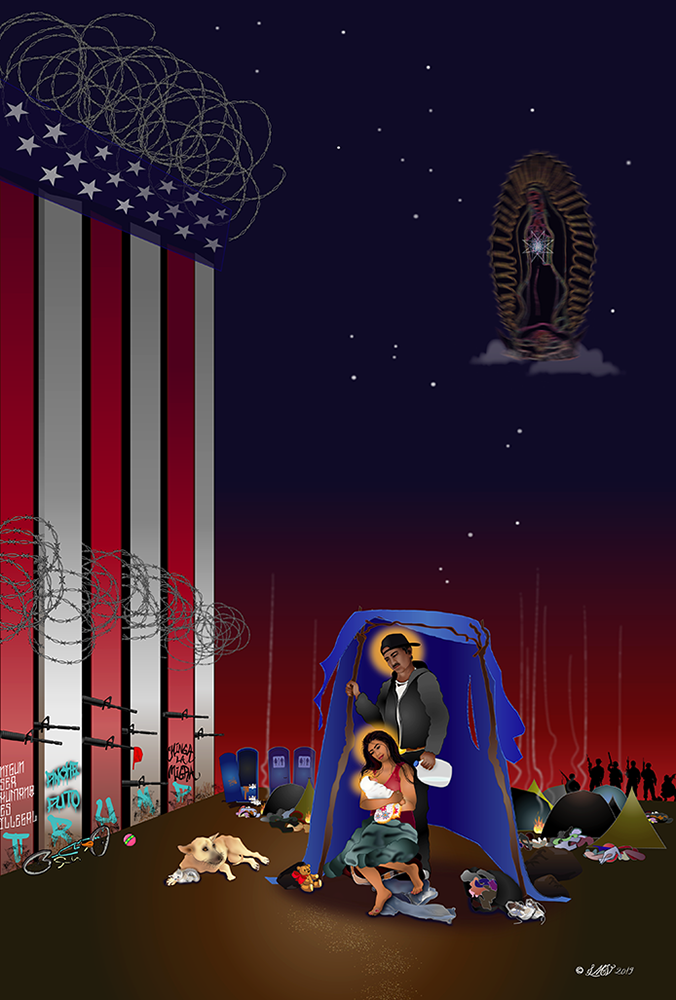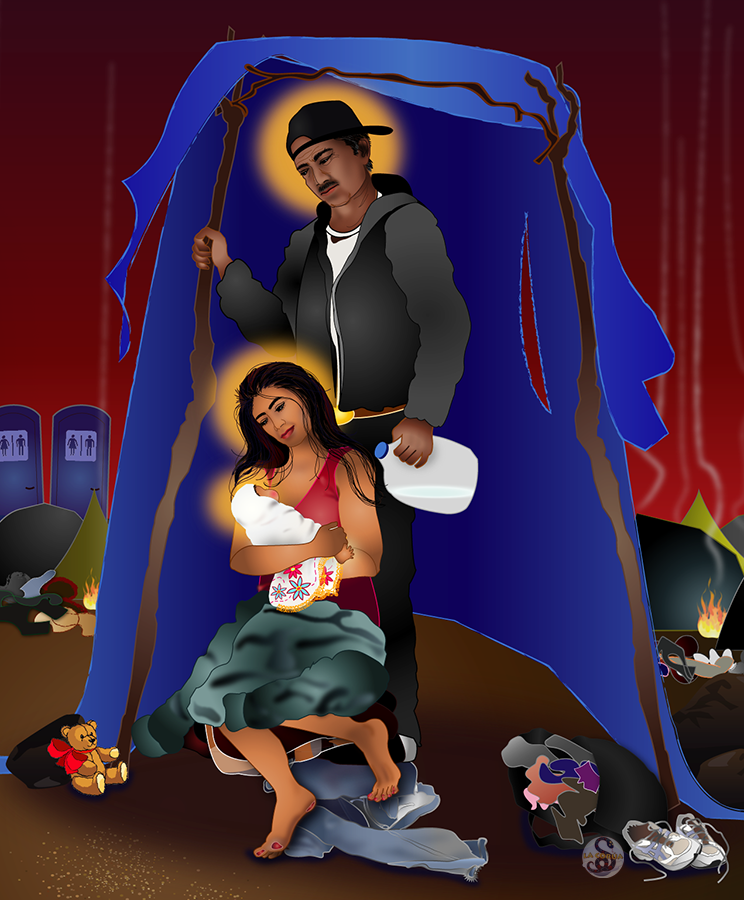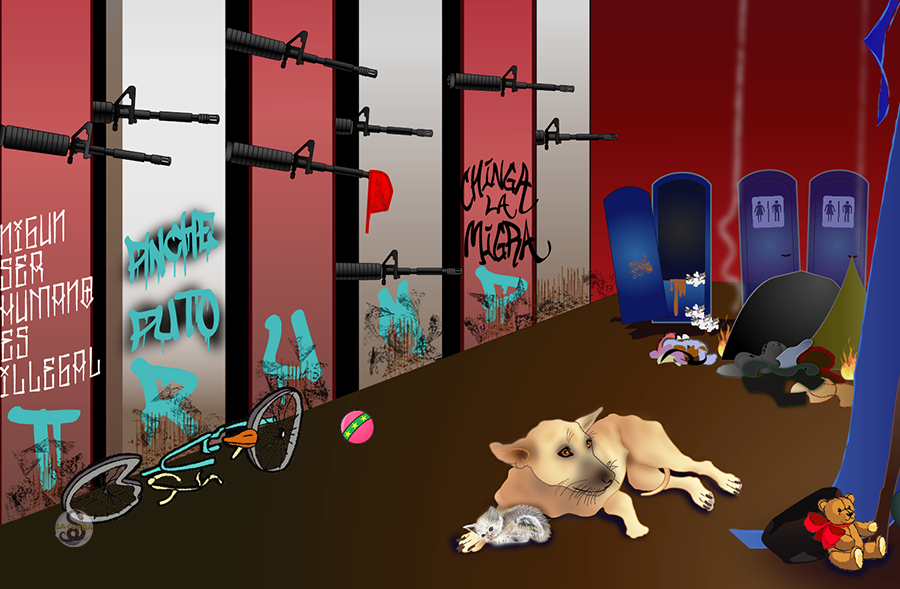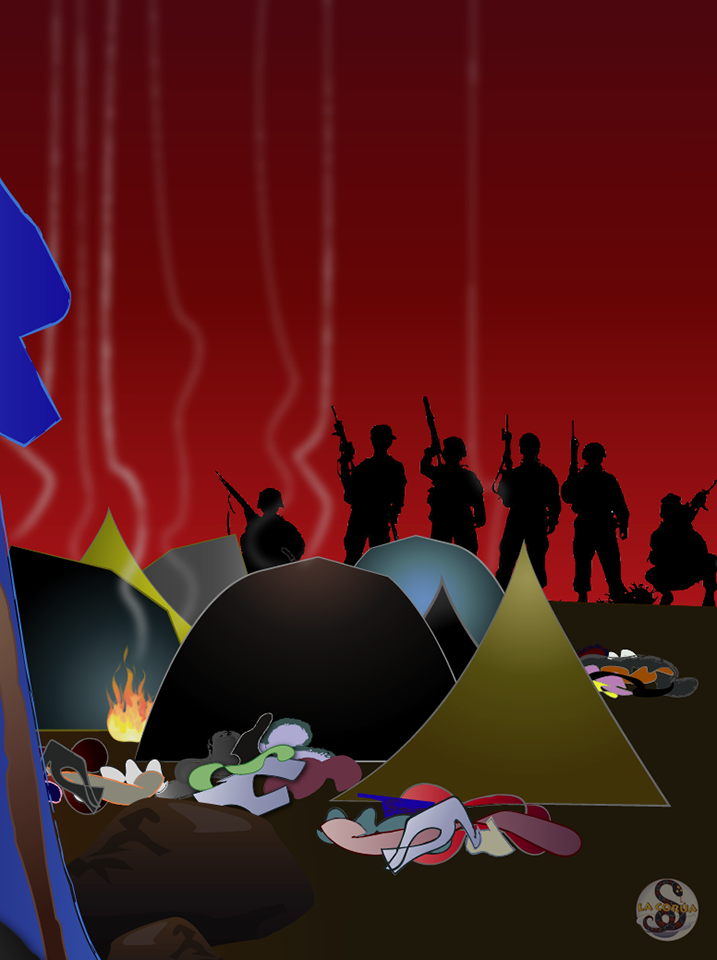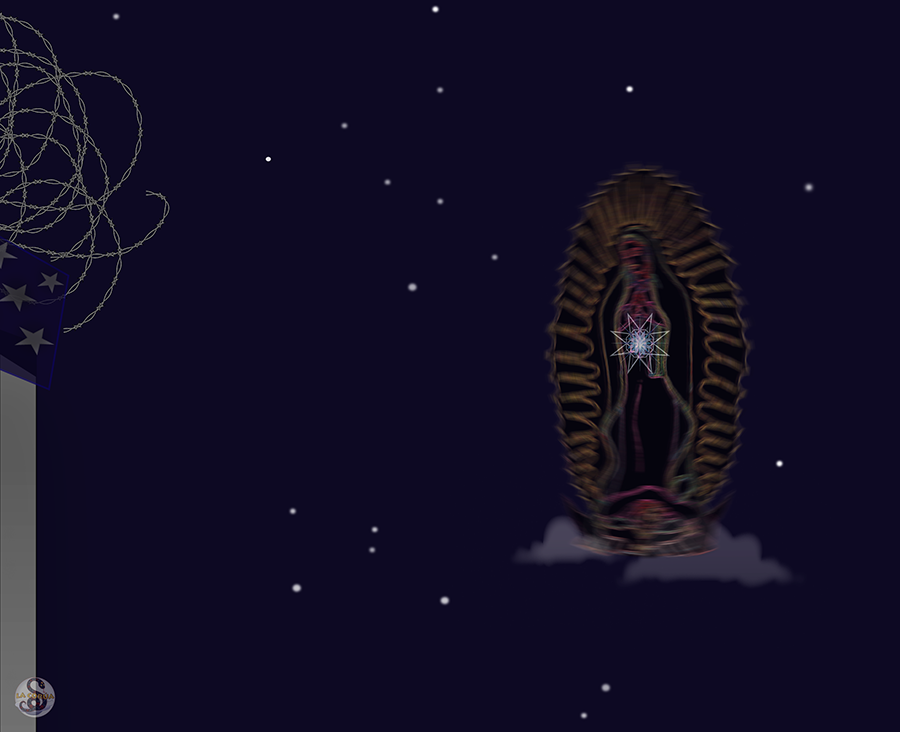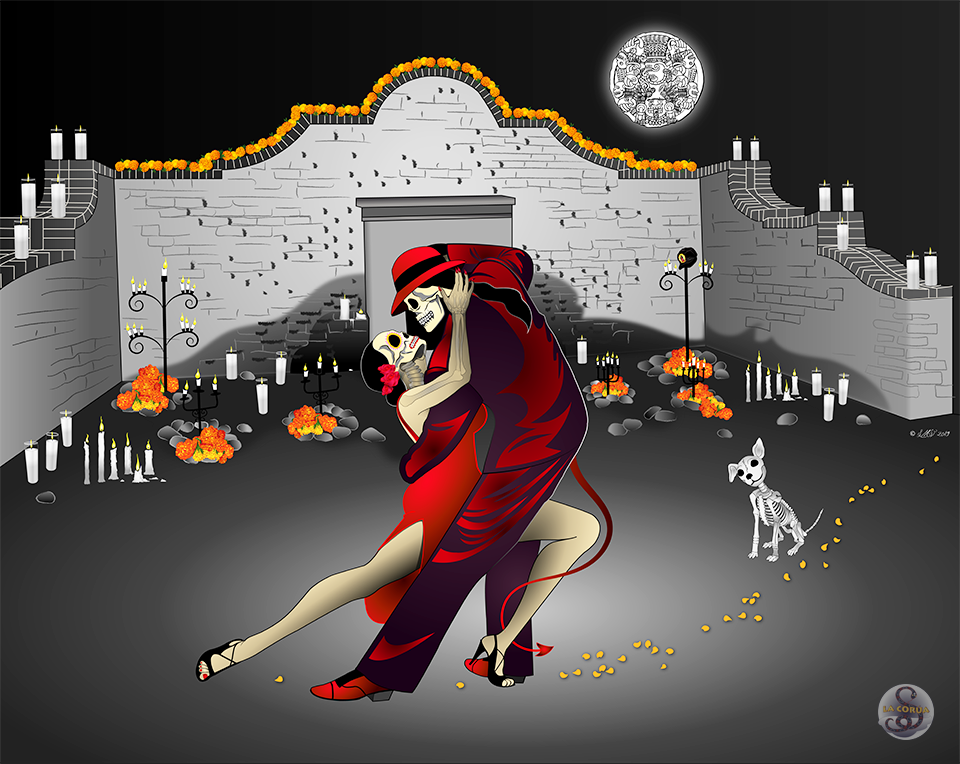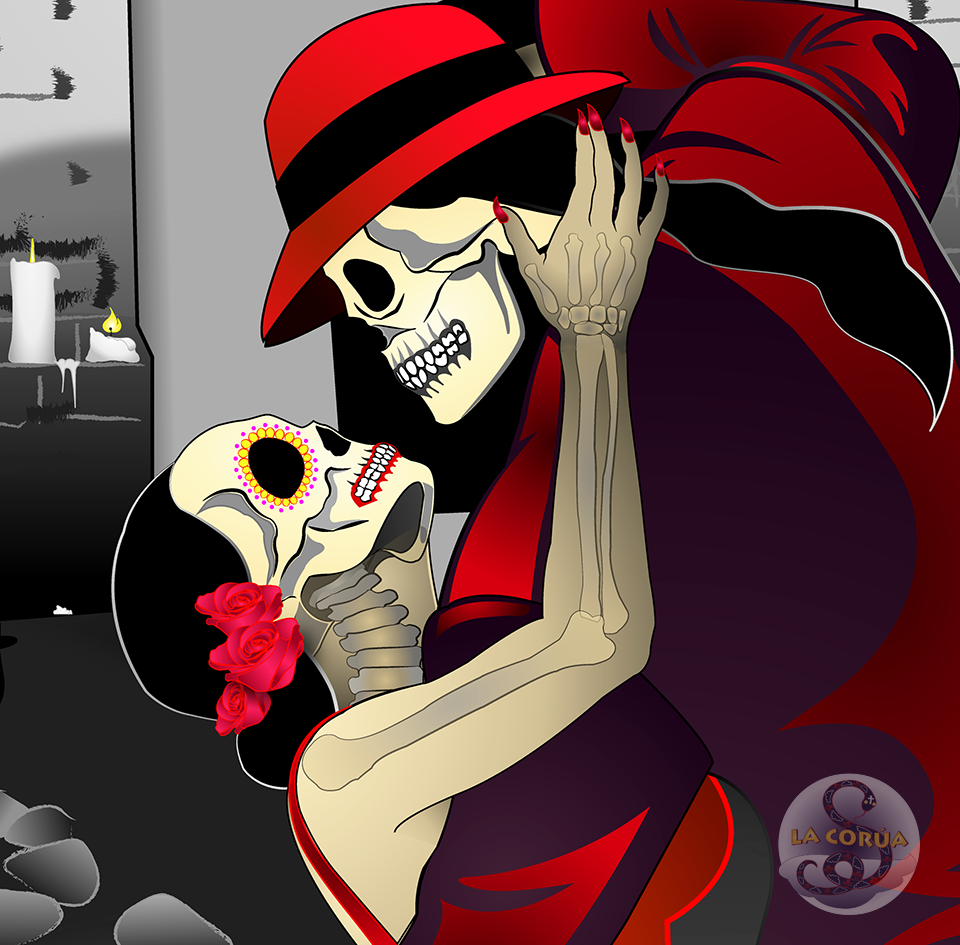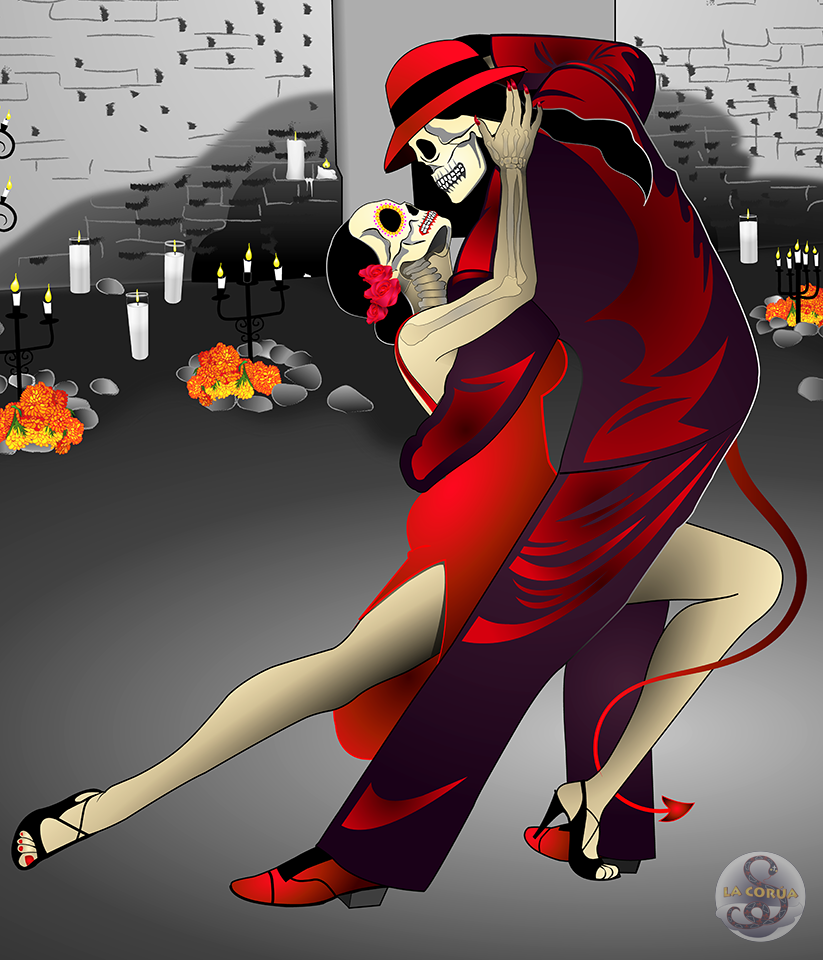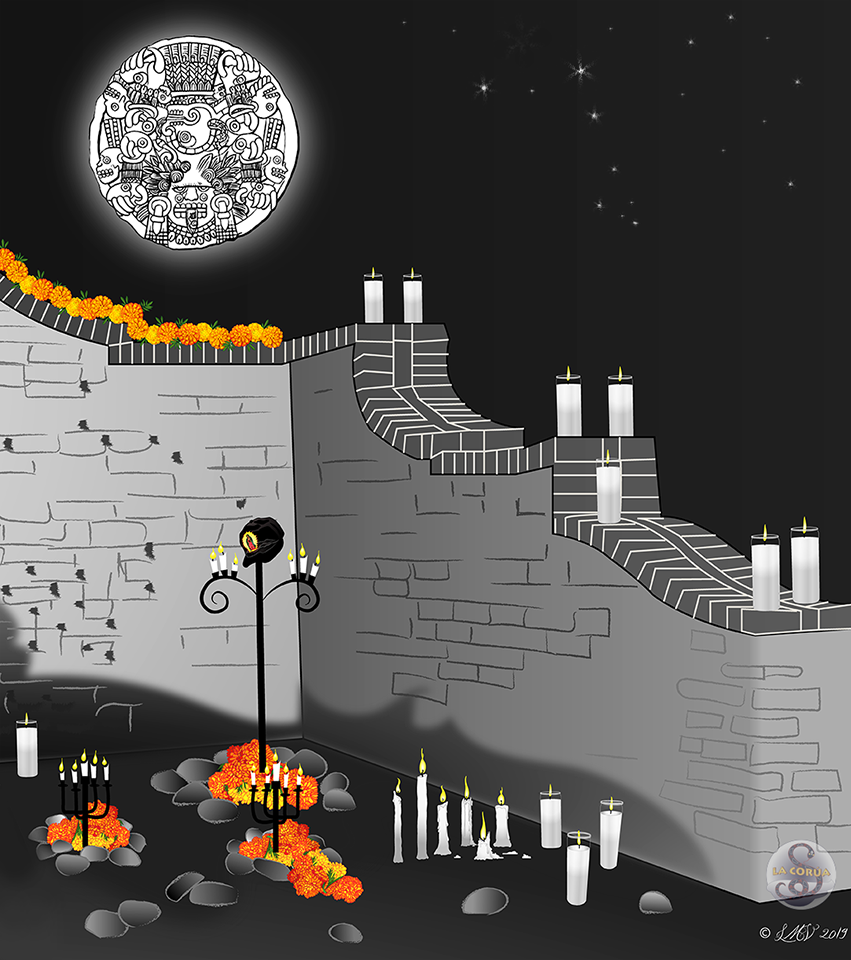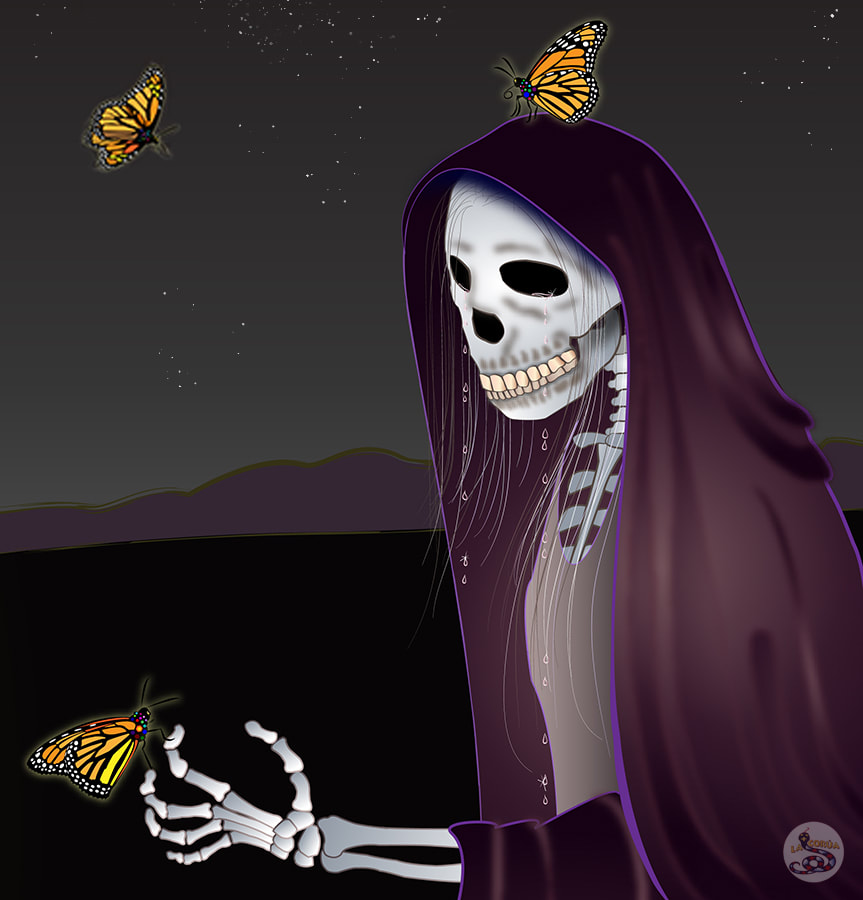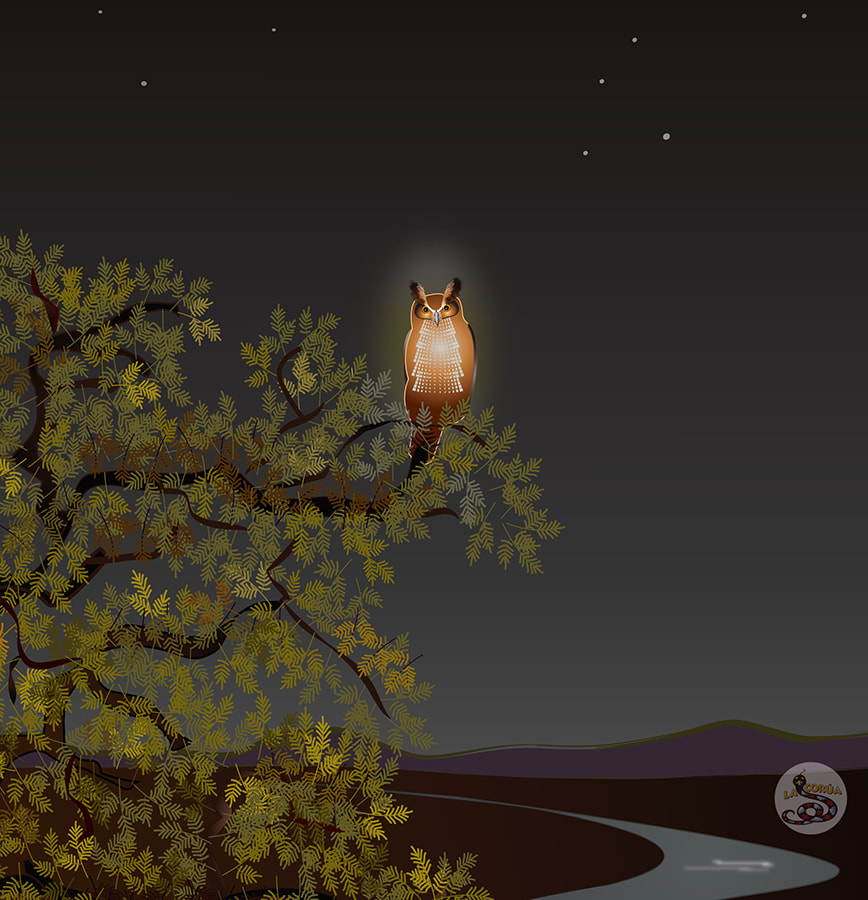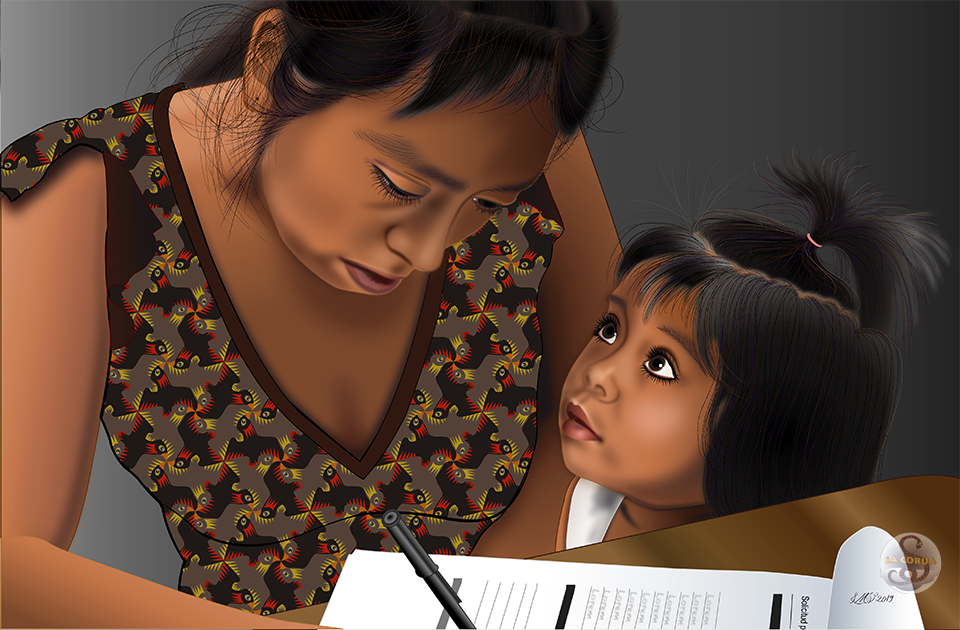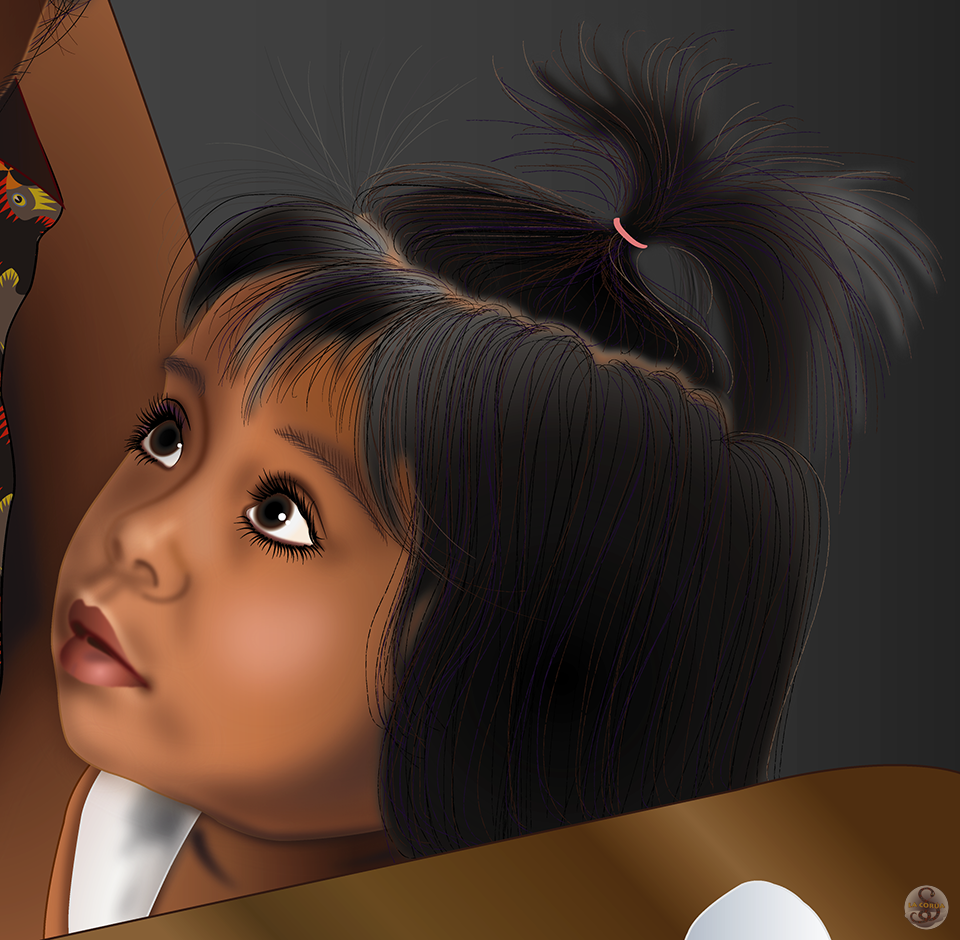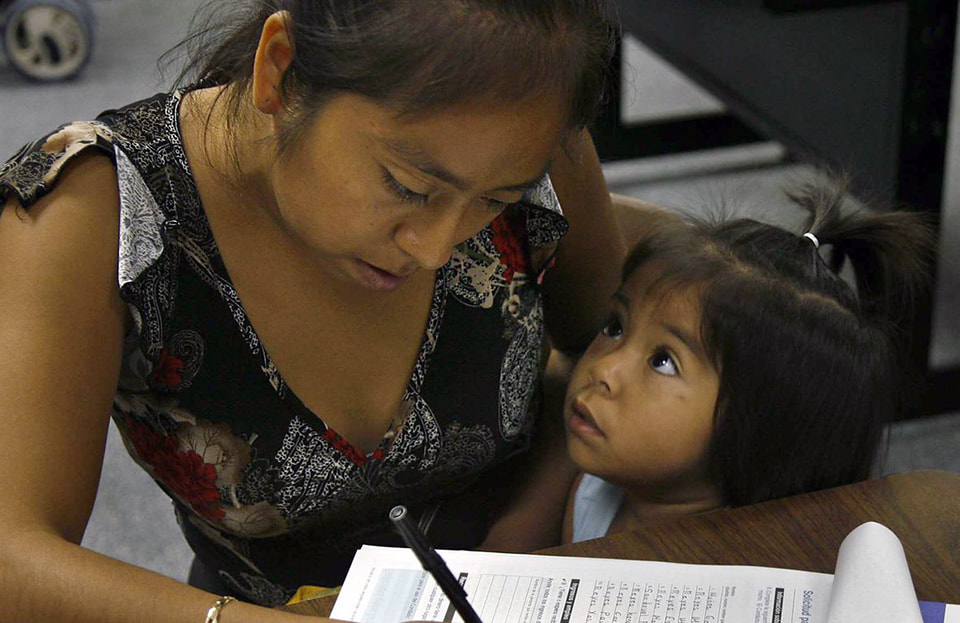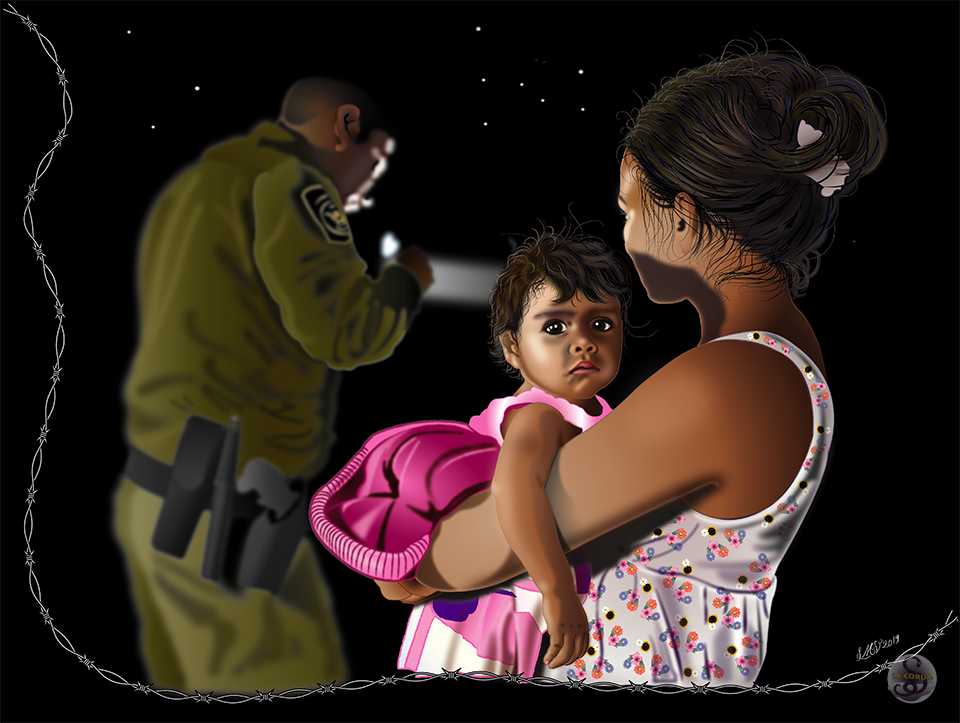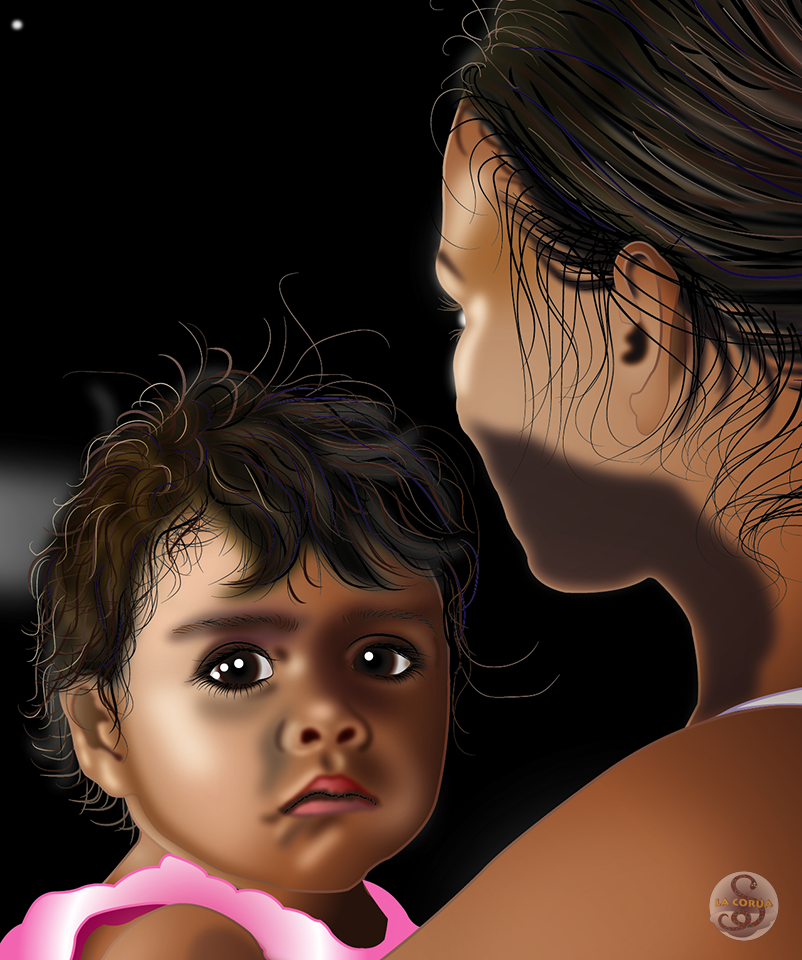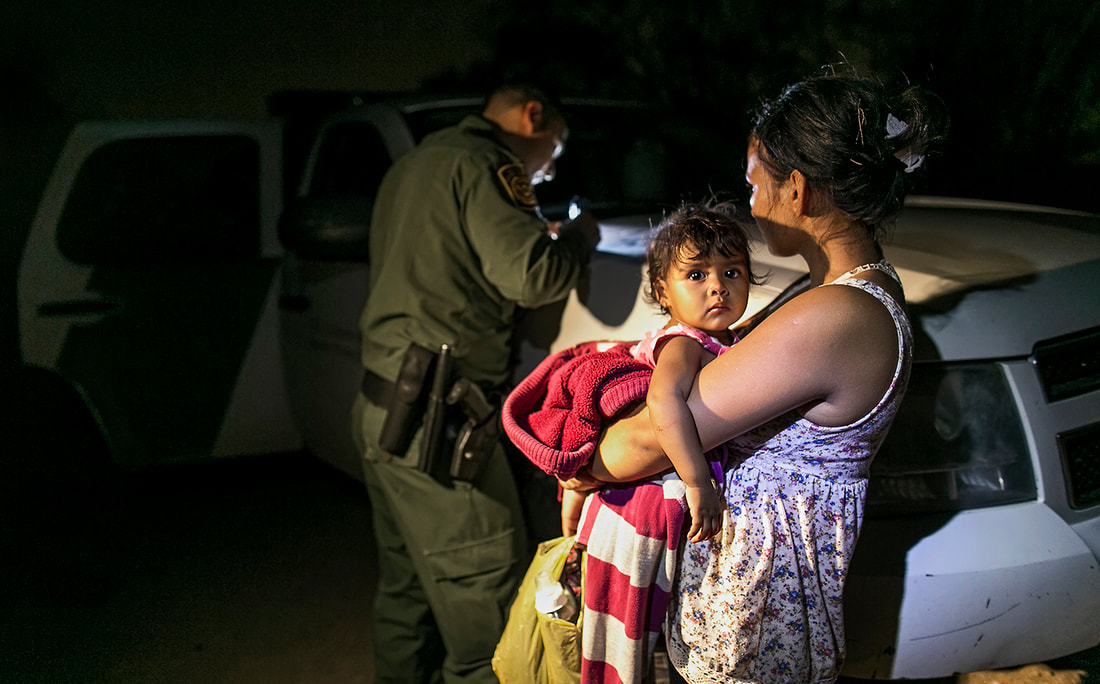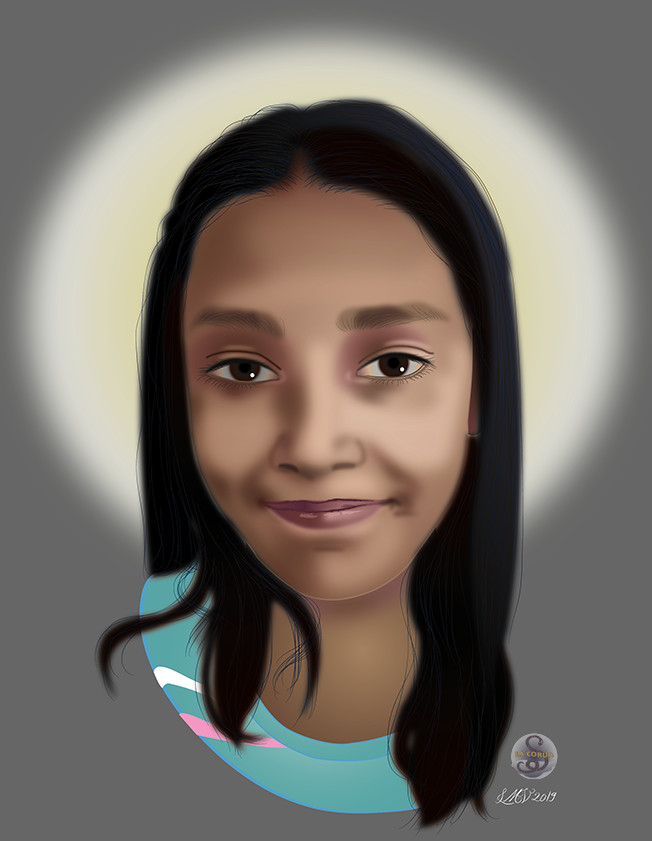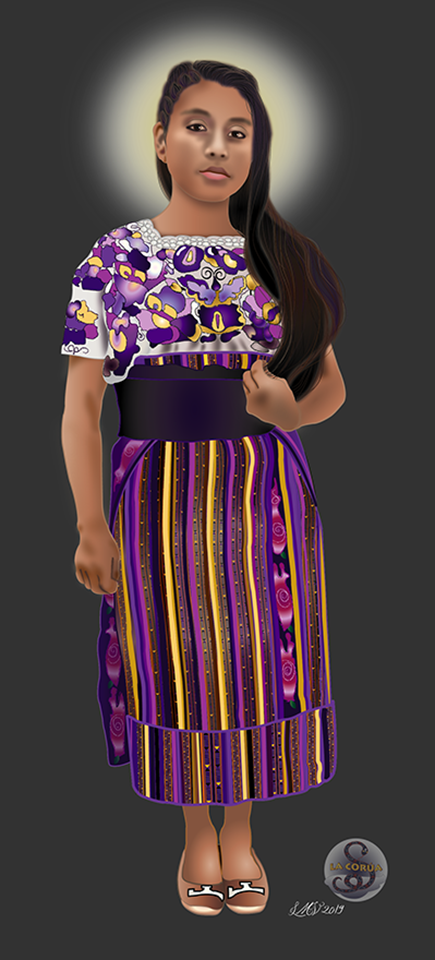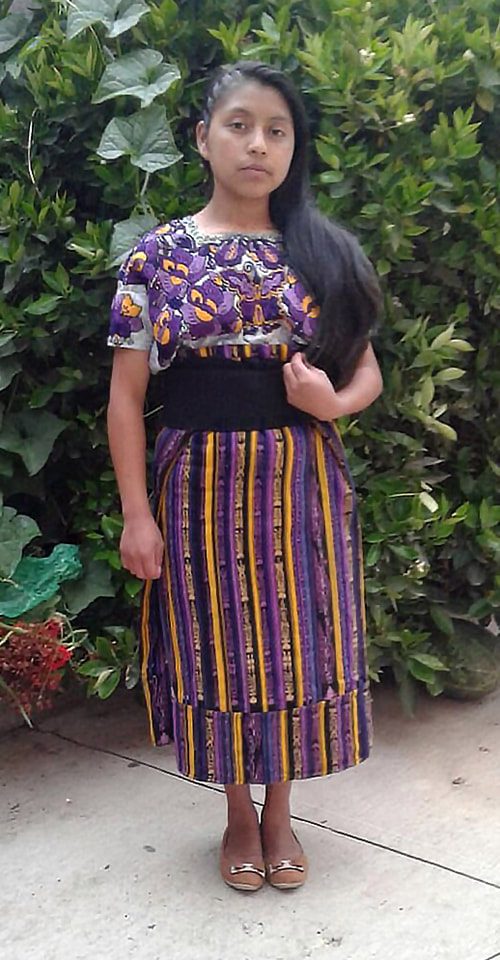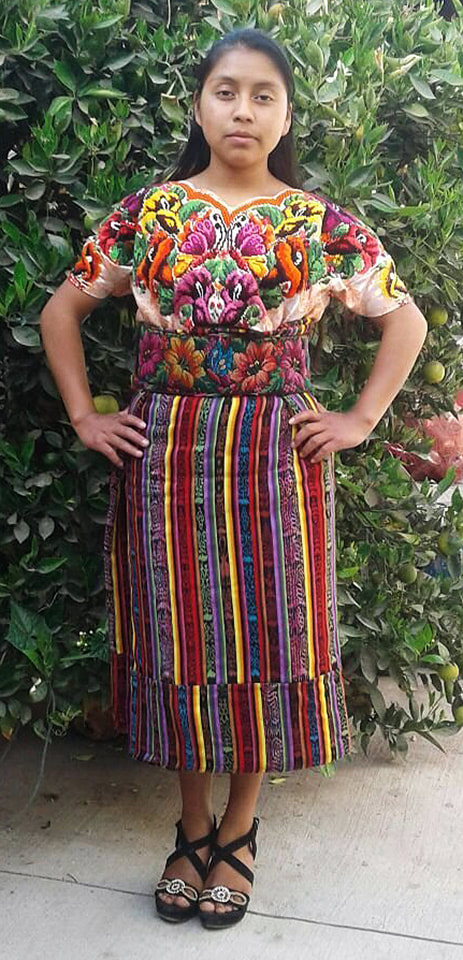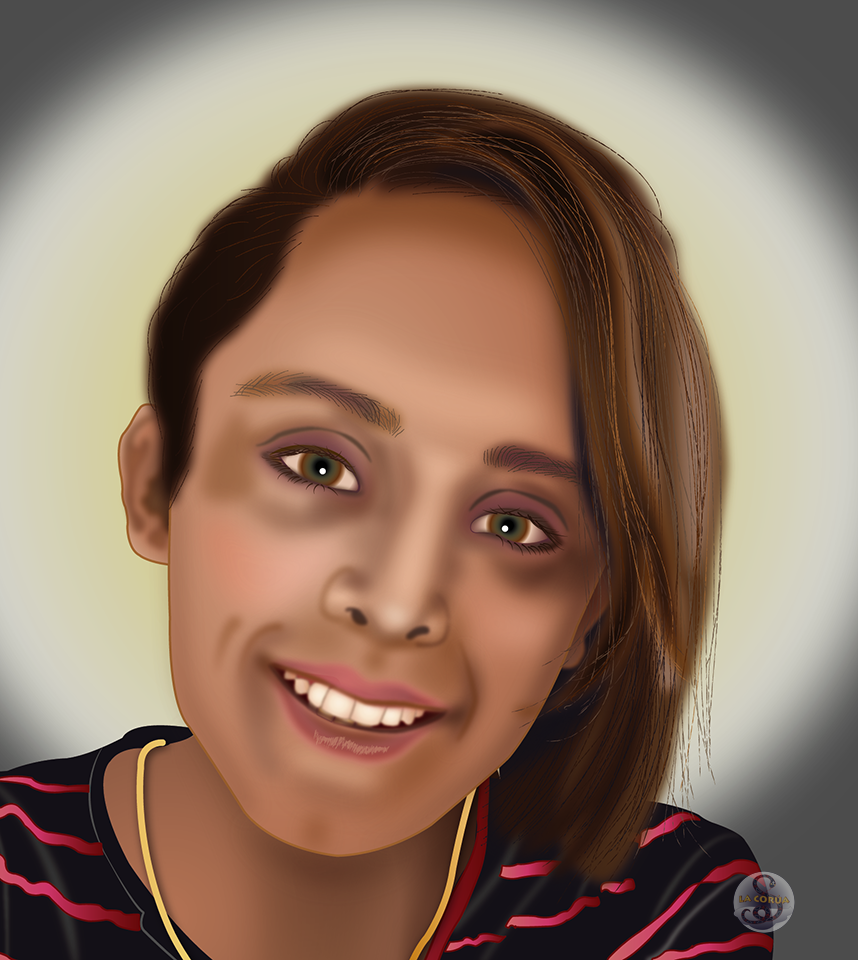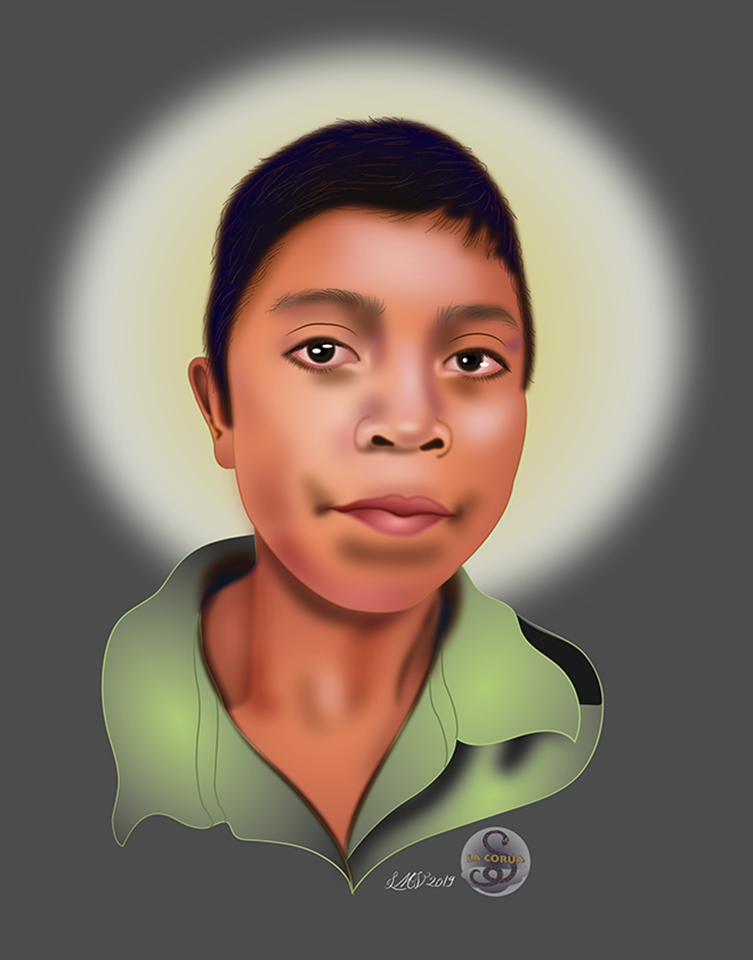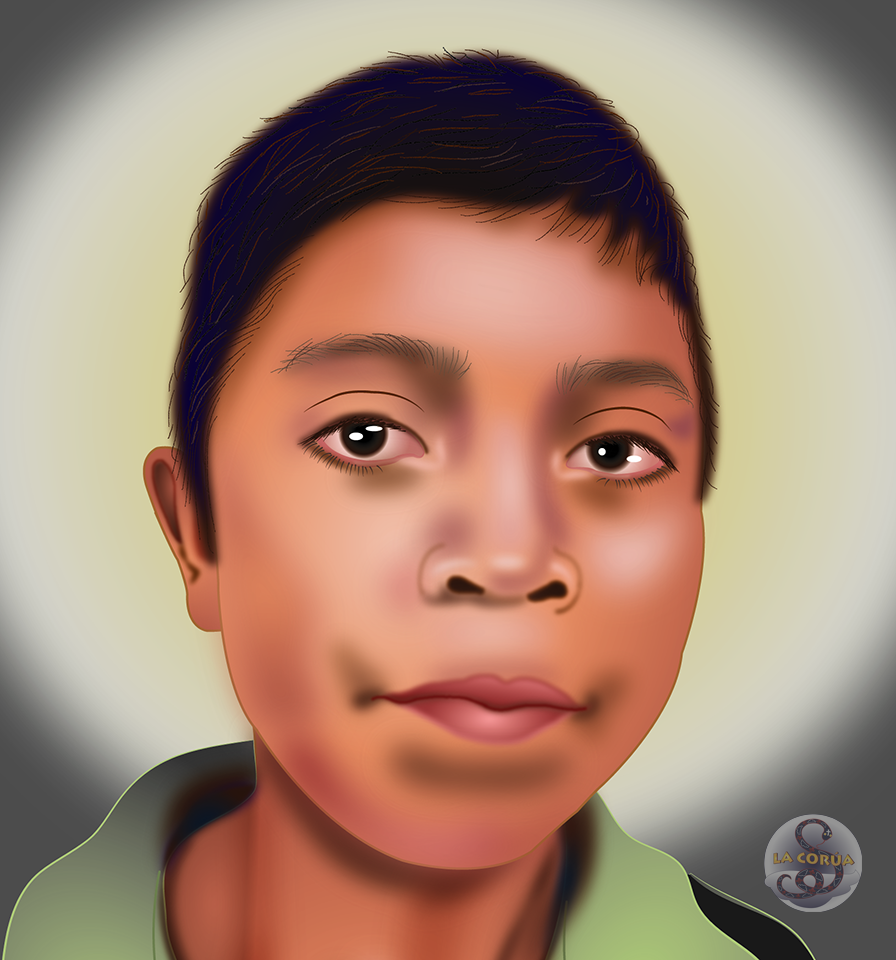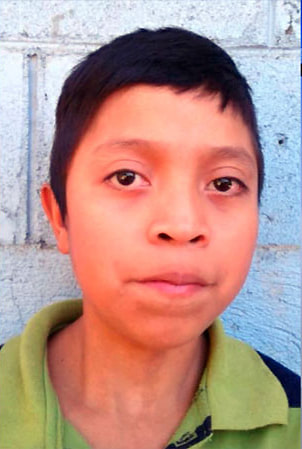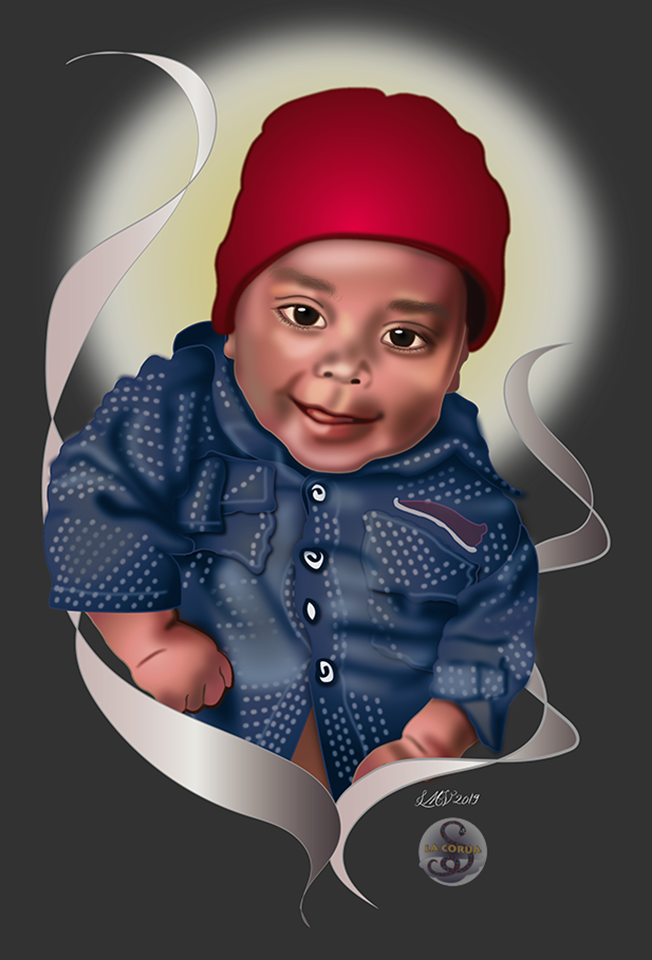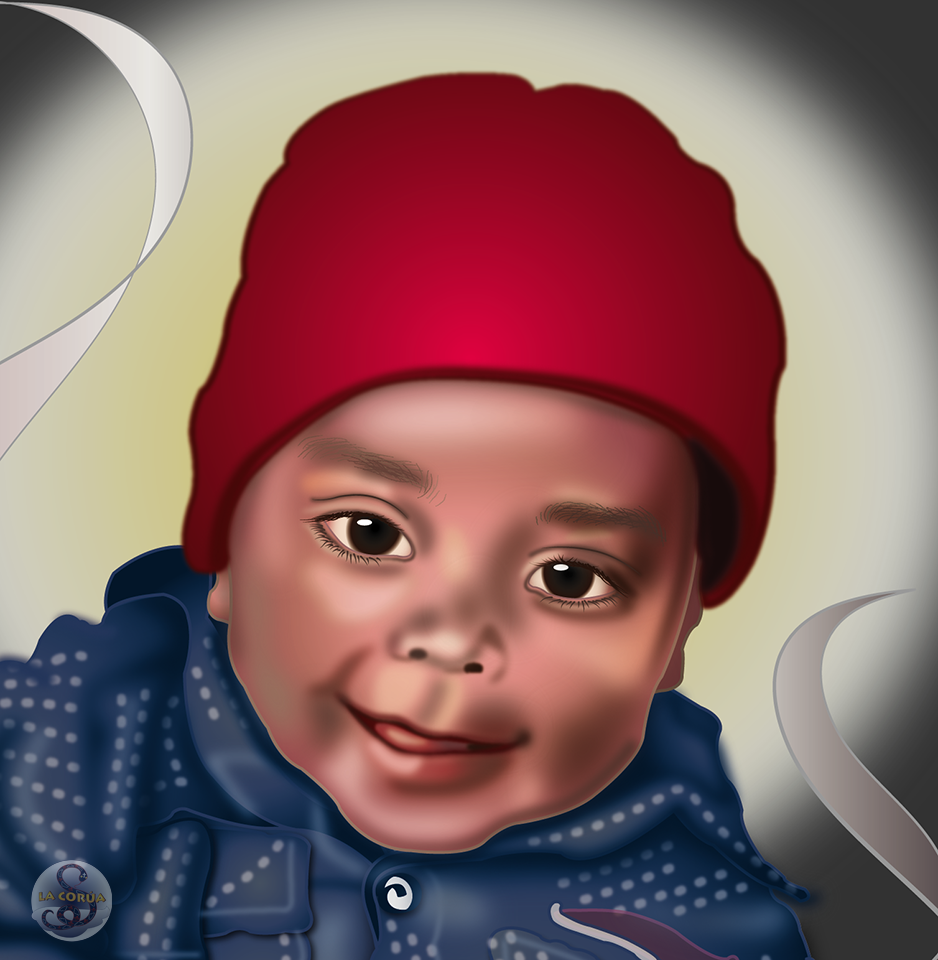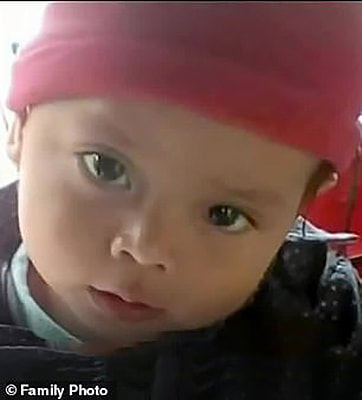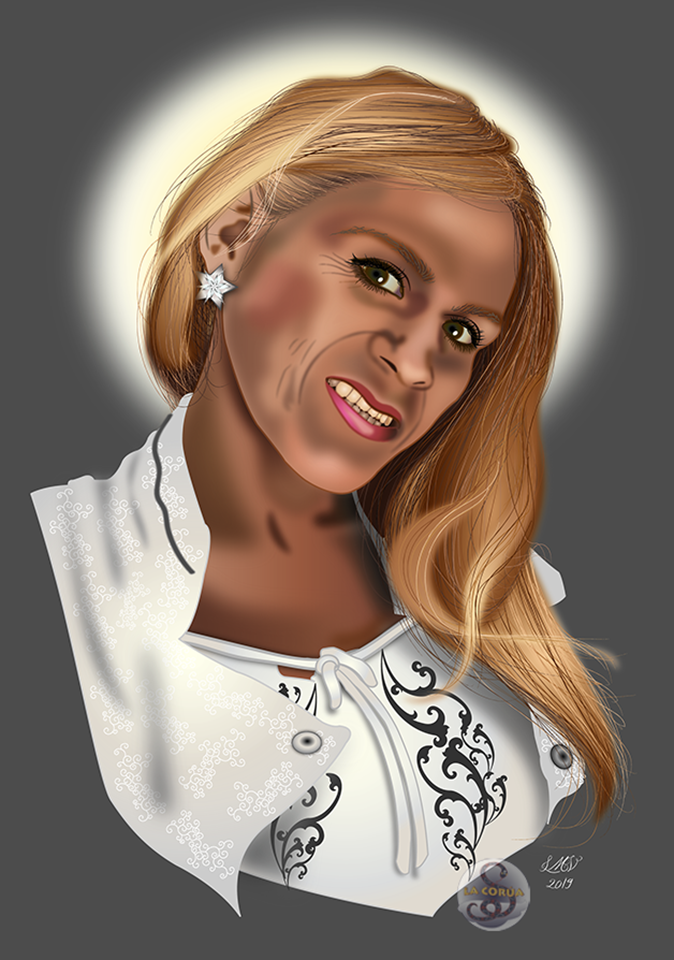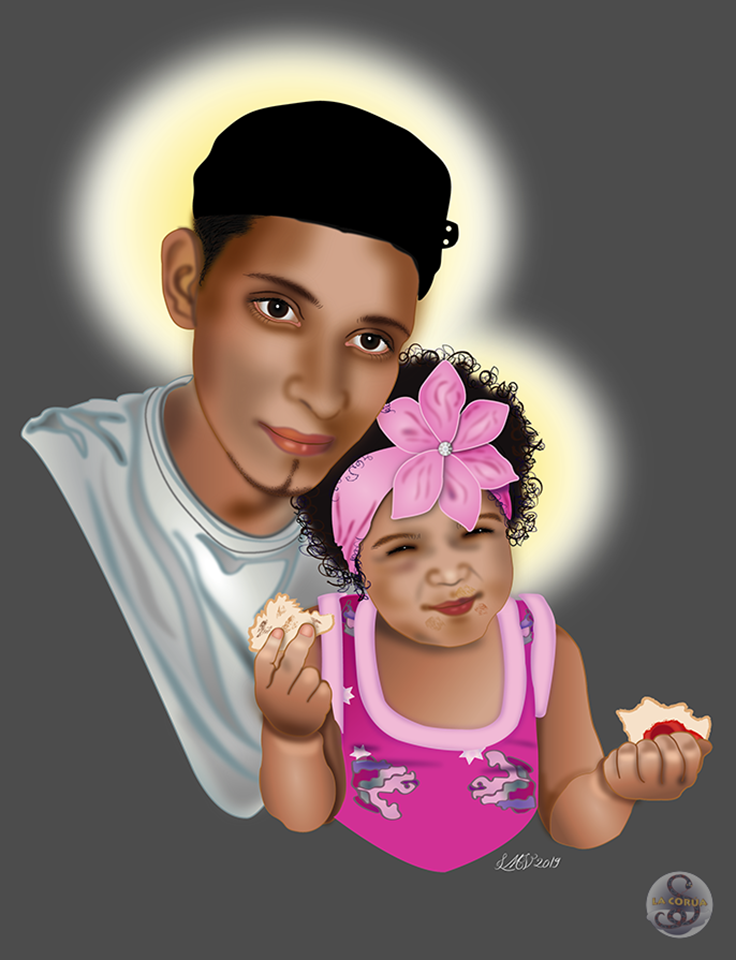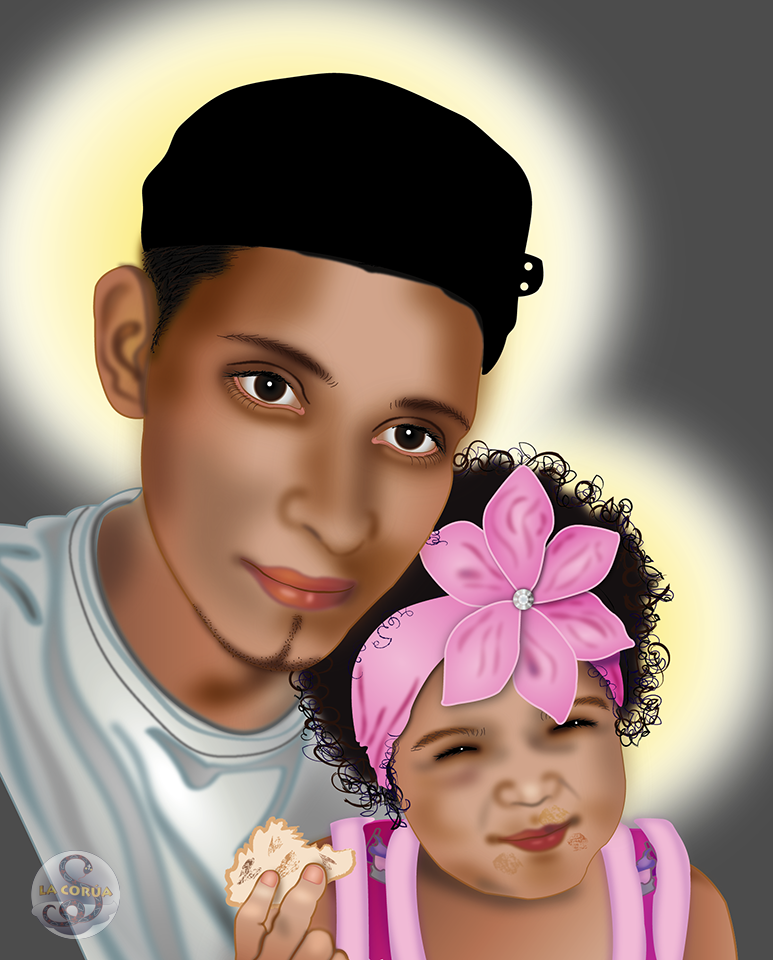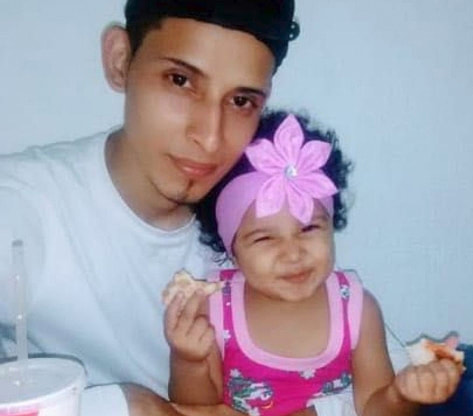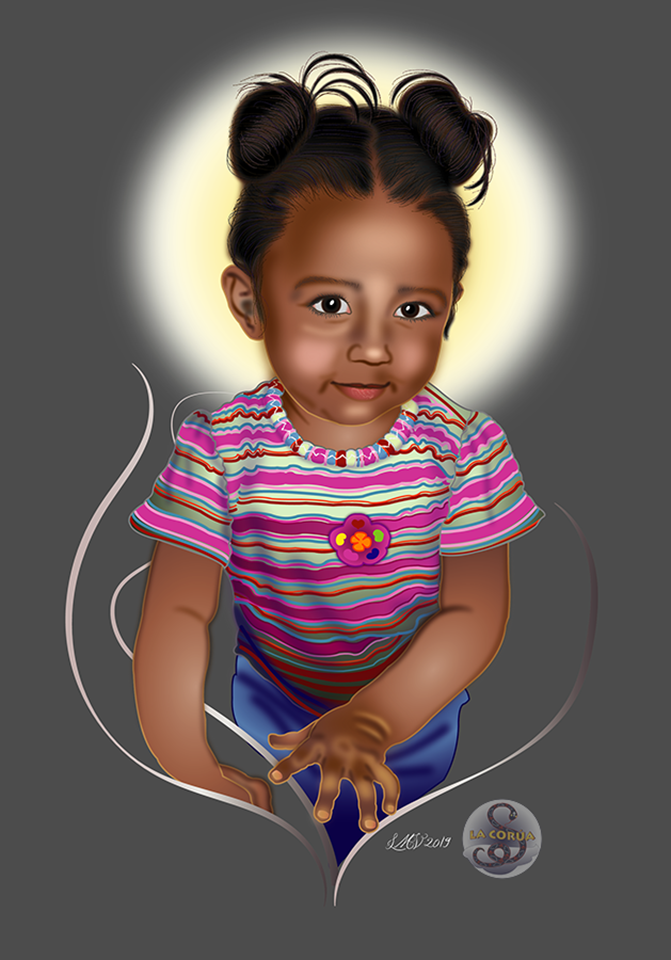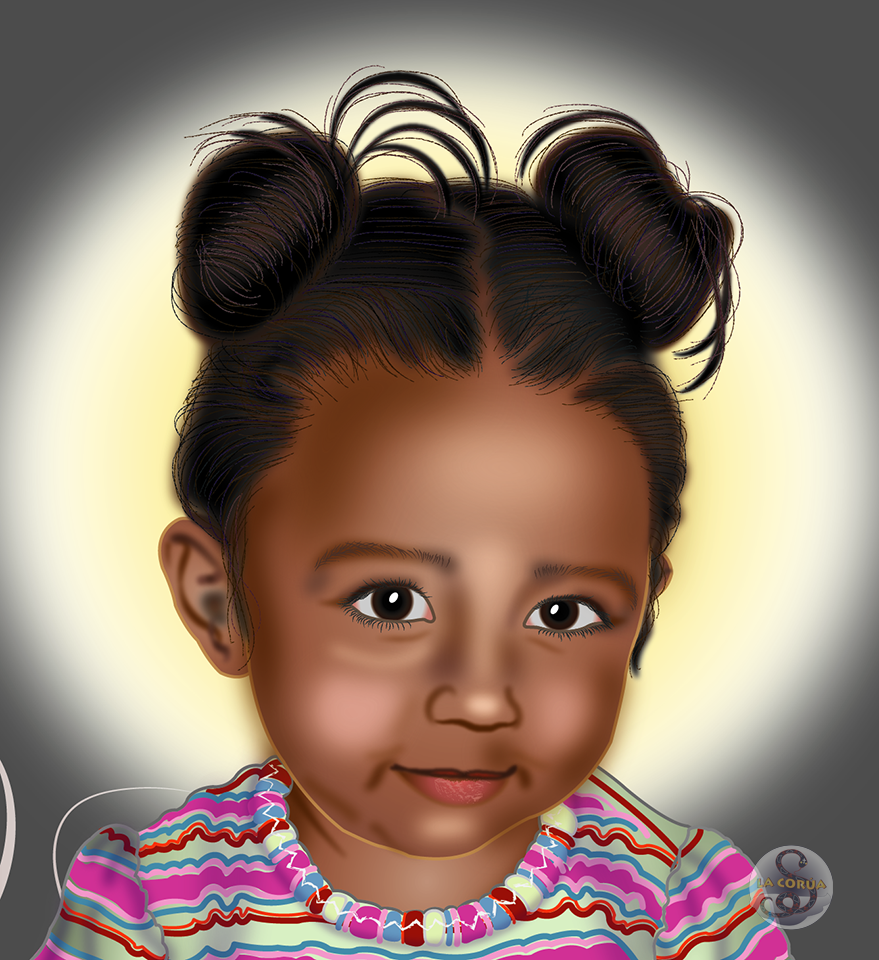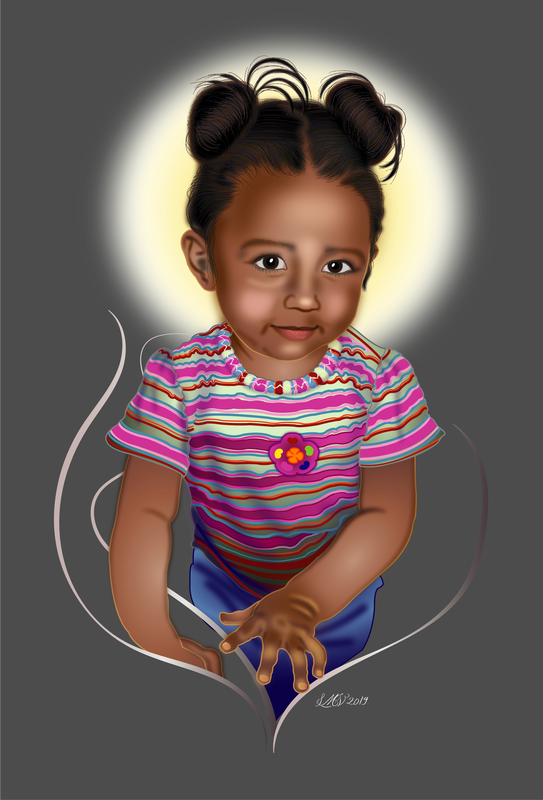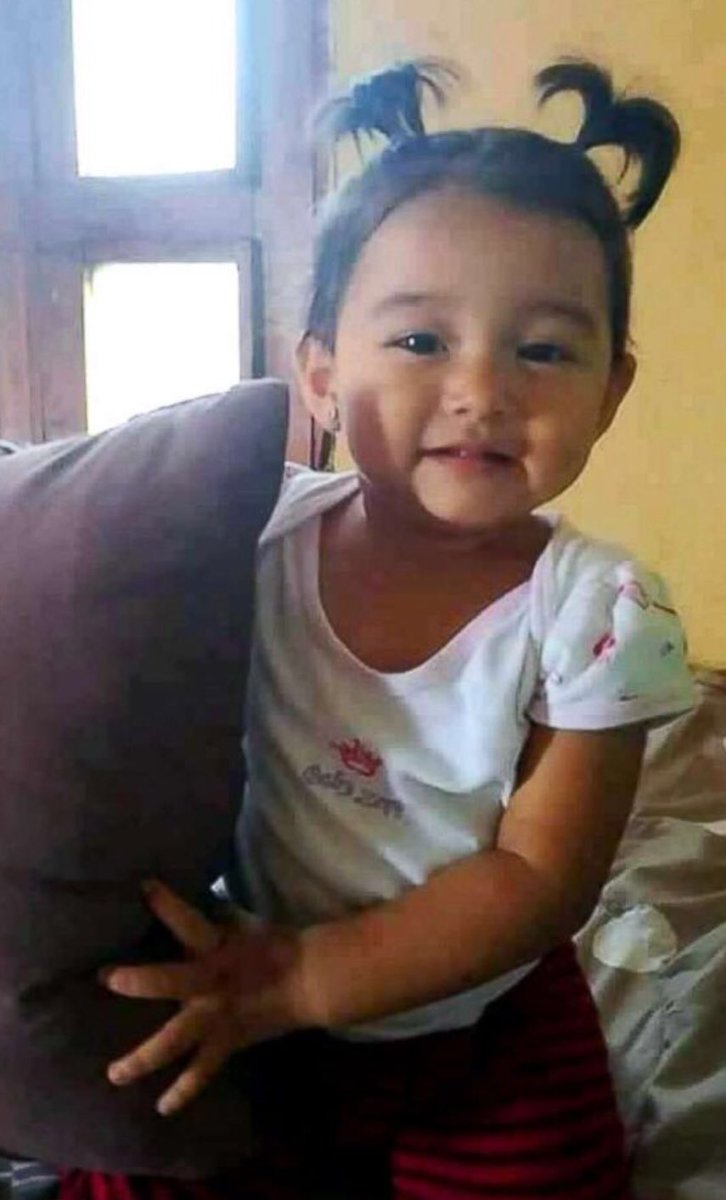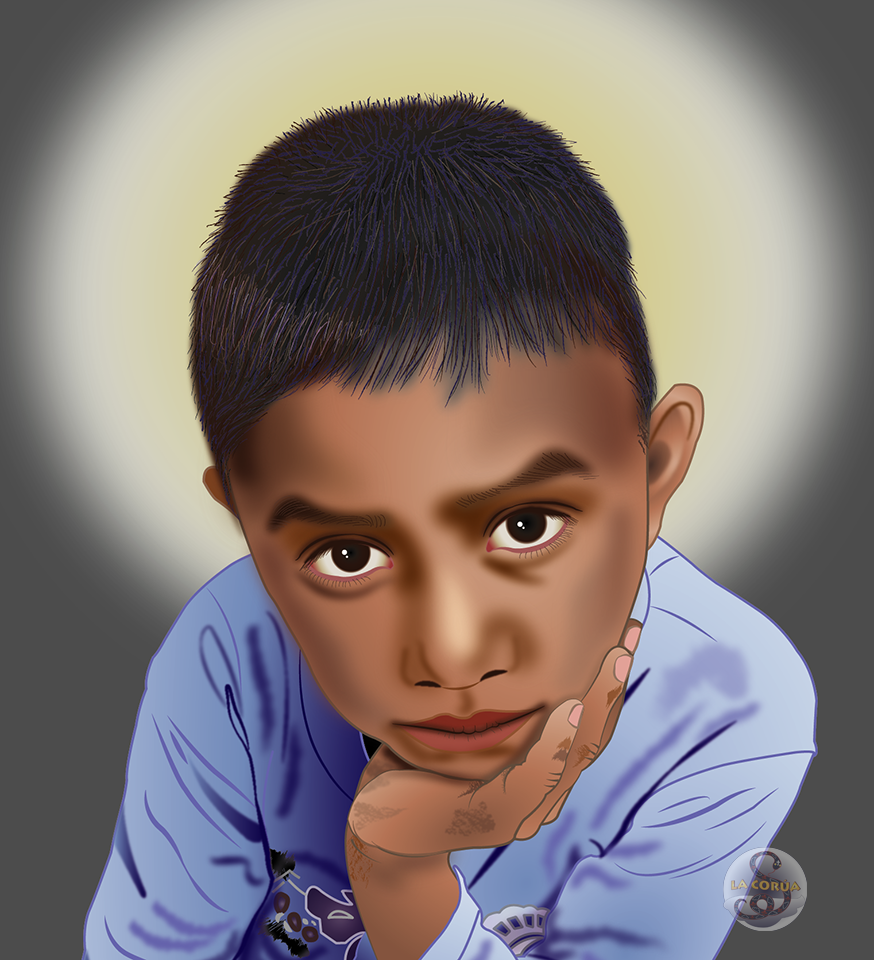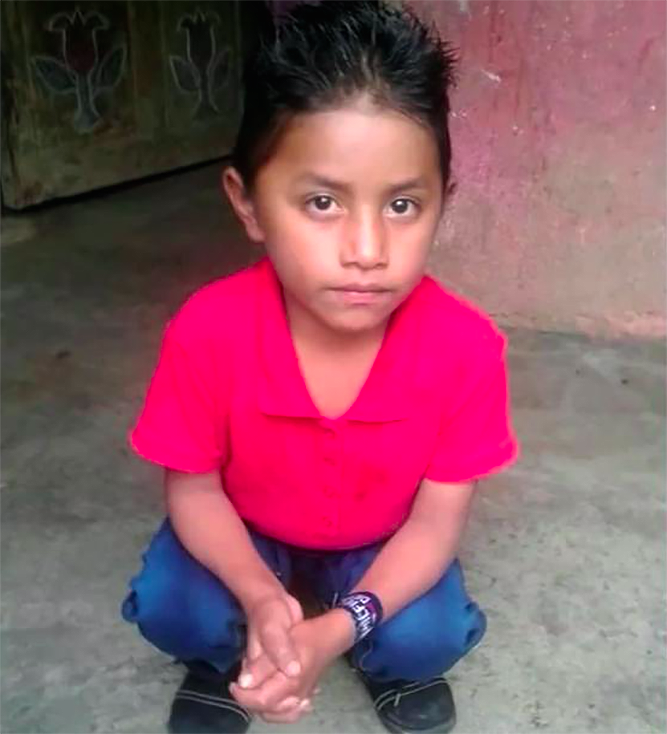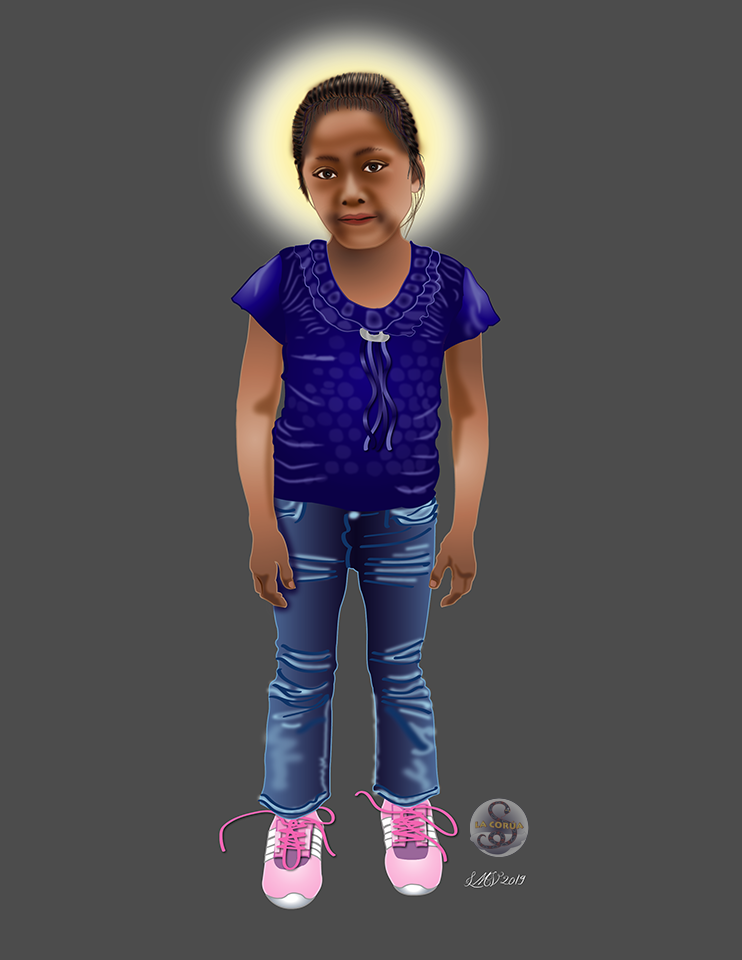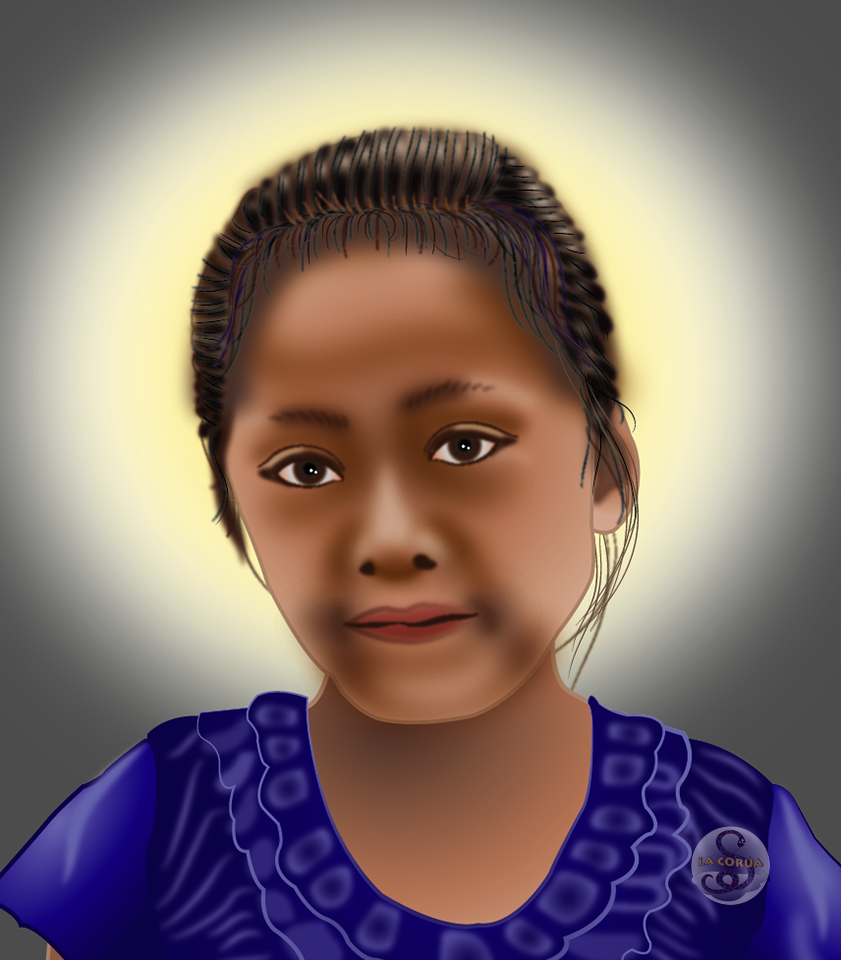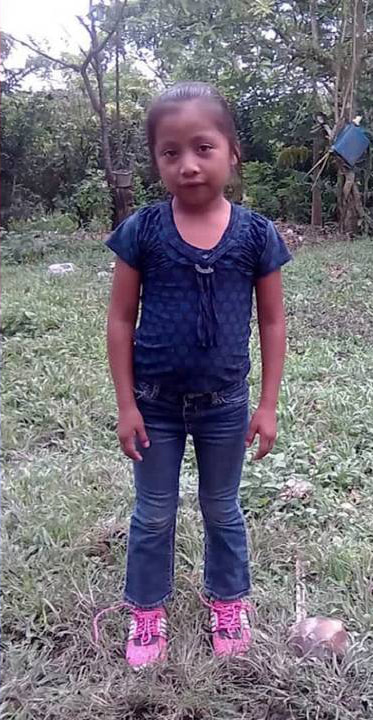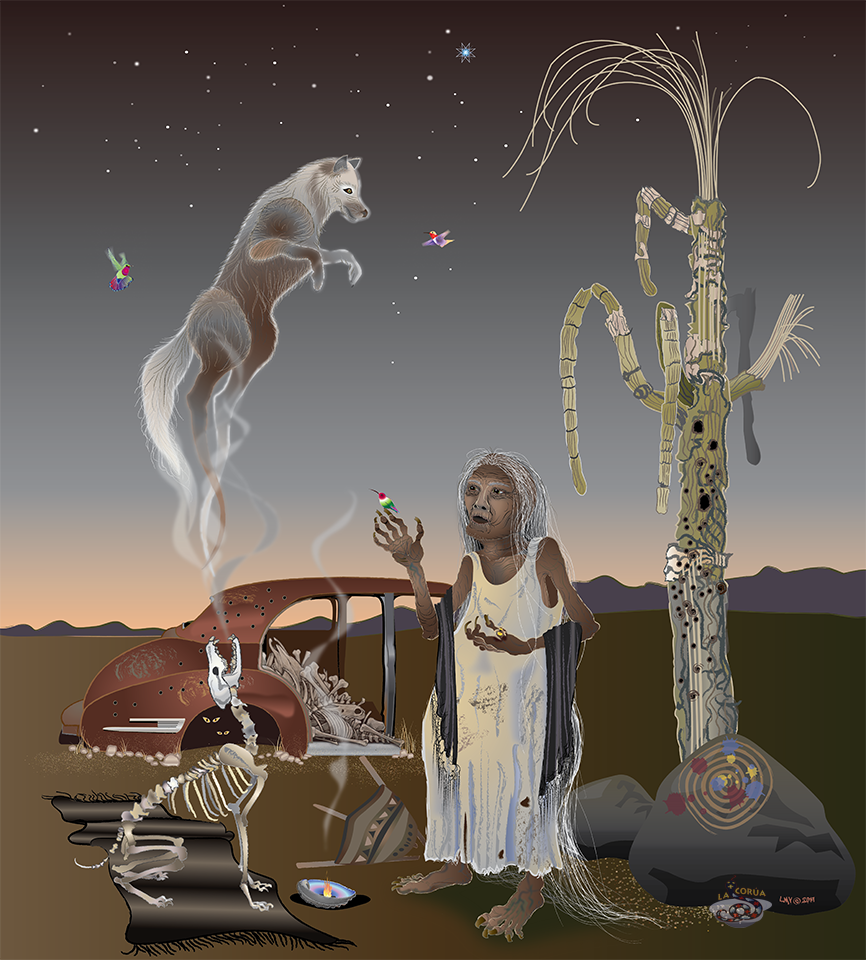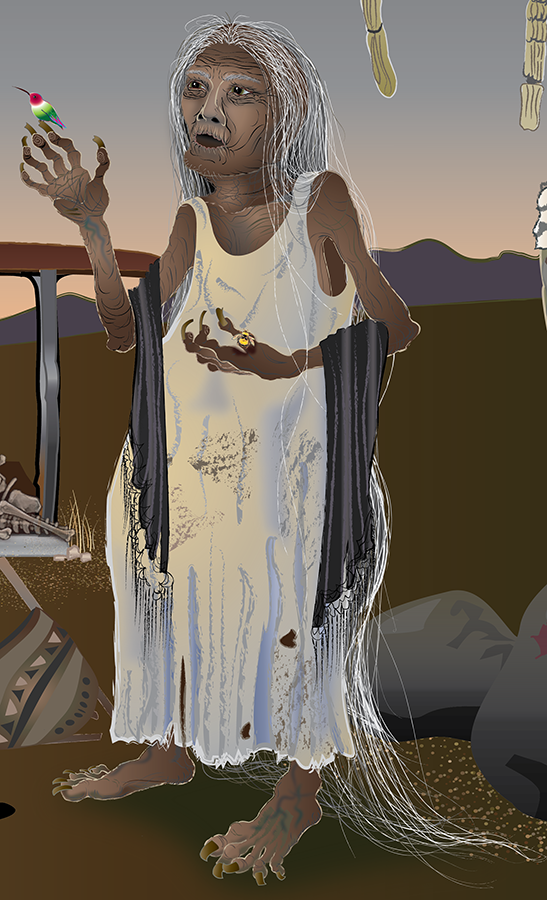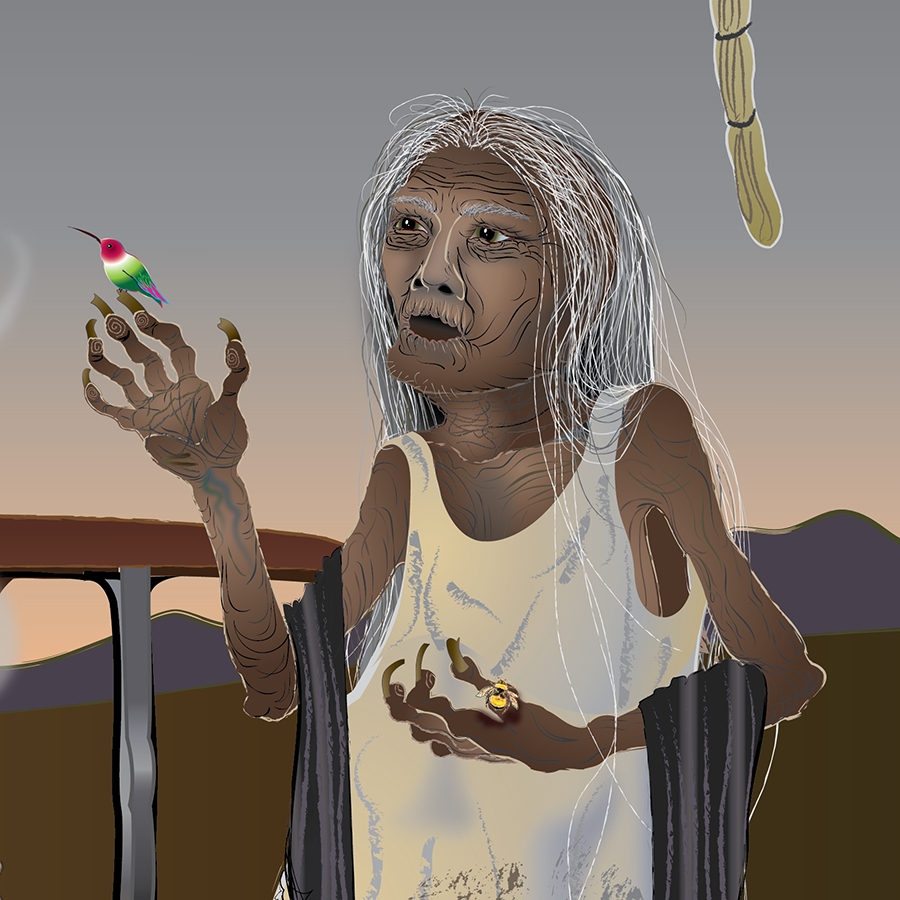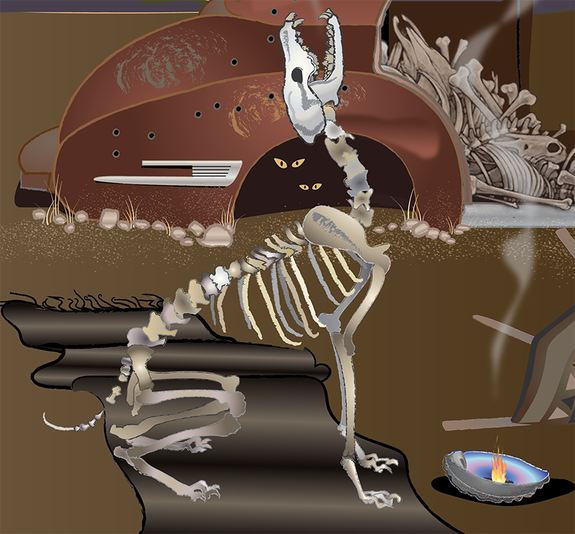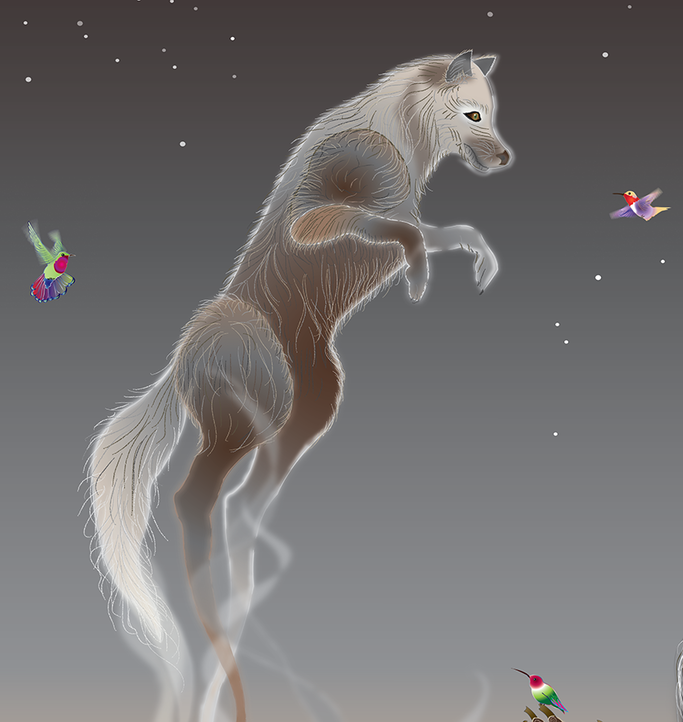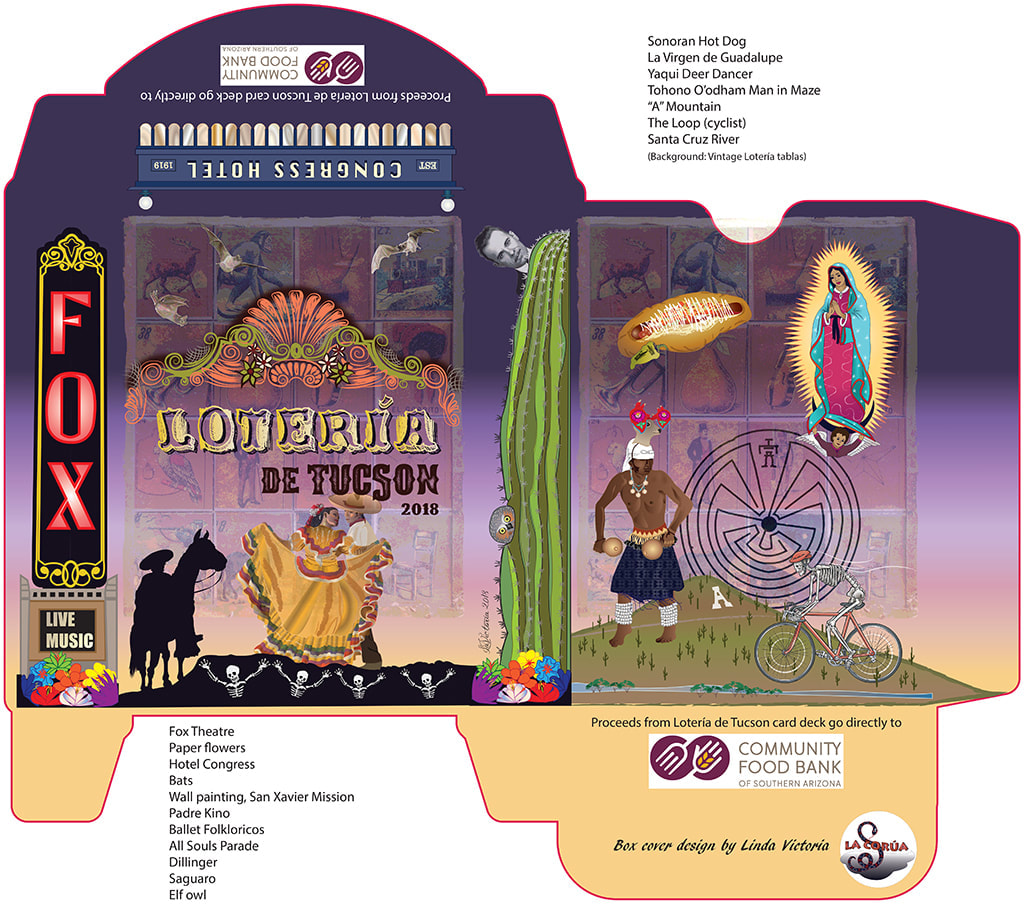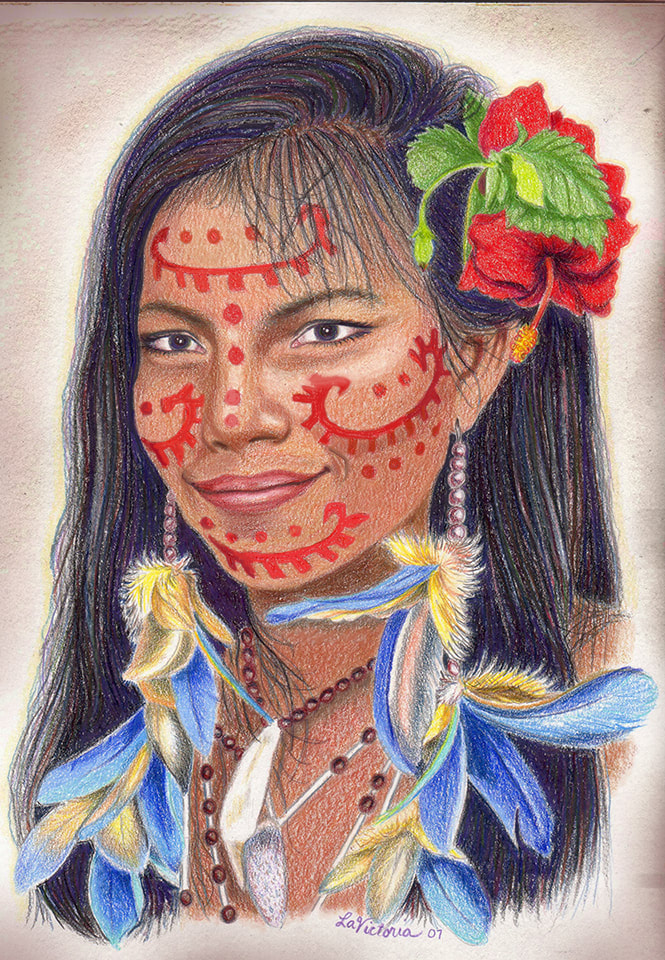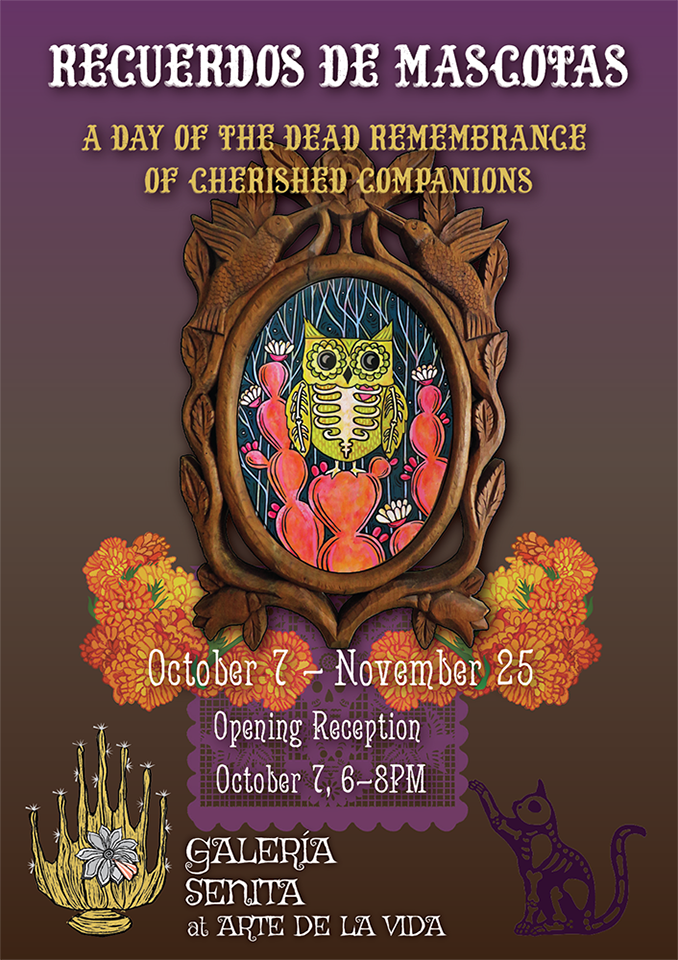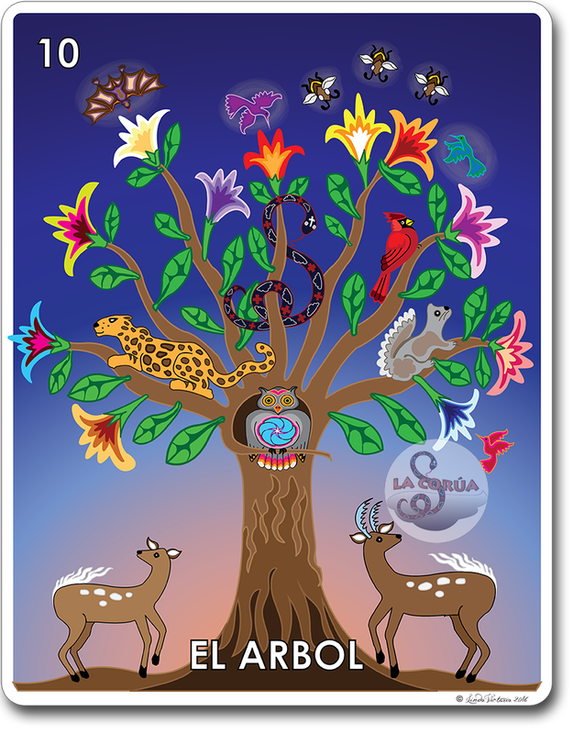|
The face is how a soul presents to the physical world throughout its lifetime. Although it's been said that the face is just a mask on what's hidden underneath, for me, the face hides some things while revealing others in stark reality. Let's say someone has endured a difficult upbringing yet harbors no bitterness and takes life in stride. A relaxed radiance (often accompanied by hearty laughs) shines through in their smile. Their age and/or physical appearance matters little. The goodness you feel from being around people like that is contagious, and lifts your own spirit. This is true with my sister-in-law of 45 years in New Mexico. A native of Santa Fe from a large family, she has been a mainstay in ours, while lending heart and hands to the survivors in her own family without hesitation. I'd been wanting to give her something special, just for her, for years-- and finally had the thought to paint her. I asked my brother for his favorite photos, and gleaned my favorites from their Facebook pages. What I ended up with was her smile. Every age, every occasion, her smile. I combined aspects of several photos over a span of years to finally arrive with that timeless smile and boundless heart. That is what I see... I hope you do, too. Continued from Home Page: For original residents - Mexican, Native, Chinese and African Americans, remaining in their home barrios around the A-Mountain area today is challenging. Poverty continues its downward grind on residents not eligible for opportunities and resources. Arizona's libertarian laws cater to high-end investors (often out-of-state) and have made massive changes to the Greater Tucson area through the years. It is a system long favoring whites over minorities, and eclipses local laws and ordinances. Existing inhabitants have been evicted or bought out on the cheap-- taking with them the cultural richness and living history that made their real estate so coveted by outsiders. Yet, silently, eternally, guardians of The People, and of The Earth are here. They do not prevent changes, but they are here and are not forgotten. And they have been here since the beginning. They plant the seeds of survival and wisdom in every new generation. Tucson's spiritual heritage is a unique amalgamation of Tohono O'odham and Mexican Catholicism coexisting without the bloody subjugations that defined other regions of the American Southwest. It became further enriched as waves of Pascua Yaqui (Yoeme) Indians migrated from their homelands in Sonora escaping genocide by President Porfirio Diaz of Mexico, bringing their own earth cosmology mixed with Catholicism absorbed from Jesuit priests in the 1600's. I'itoiThe master guardian spirit of the Tucson region, the one who was here first is I'itoi; the creator of the O'odham people and their ancestors the Hohokam ("the People Who Are Gone"). He brought the people up like children and gave them the gift of the Himdag, a set of commandments guiding them to live in balance with the world and interact with it as intended. A timeless entity assuming a number of powerful forms in tribal legend, he retired from the world and lives as a little old man in a cave beneath Baboquivari Peak - the original place of emergence from which he led his people out of the underworld after a great flood. I'itoi's people have inhabited this land for over 10,000 years, and they believe he watches over them today; their 'Older Brother' from his sacred home beneath Baboquivari Peak, which they regard as the center of their universe. I'itoi is most often referred to as the 'Man in the Maze': an ancient design in O'odham petroglyphs, basketry and jewelry. He is the figure at the top of a labyrinth: the symbol for life's path a person travels and the encounters that impact him and direct him to reach the center where he is blessed by the sun god before passing into the next world. The O'odham have been stewards of the Sonoran Desert since before time was time. Faces of the Tohono O'odham Nuestra Senora de Guadalupe Before the Spanish conquerors arrived on the shores of Mexico, the famous mother deity we know as Our Lady of Guadalupe commonly went by the Nahuatl names Tonantzin and Coatlaxopeuh to the Aztecs of Tenochtitlan, in the Valley of Mexico. She was known in many forms: "Our Great Mother", "Honored Grandmother", "Mother of Earth and Corn", "Our Lady who emerges from the region of light like the eagle from fire", and “the one who has dominion over serpents”. The Aztecs built a shrine to her and other fertility goddesses on a hill they called Tepeyac, and had long been worshiped her there. When the Spaniards arrived, the shrine was demolished and people were forbidden to go there. The era of the Spanish conquests was drenched in blood and death. Appalled by the savage Aztec rituals of human sacrifice, the conquistadors ruthlessly crushed the Aztec empire of Tenochtitlan, decimated the population with smallpox, and pressed the masses into Catholicism. A short version of the legend of Our Lady of Guadalupe goes something like this: One day in the 16th century, a poor Indian Catholic convert named Juan Diego was passing by Tepeyac Hill when he spotted a glowing apparition on its summit. Approaching, he saw it was a dark-skinned Indian woman with stars on her cloak, a crown on her head, the moon supporting her, the rays of the sun surrounding her-- and, she was pregnant. She told him that she loved the people very much and wanted to protect them, and she asked him to have a new church built for her on the site. Juan protested, saying that the bishop would never believe he had seen her. The lady pointed, and suddenly among the cactus grew roses, a flower foreign to the New World and the flower of the heart. Juan gathered the roses in his tilma and, going straight to the bishop, unrolled the cloak. Then an even greater miracle happened: an image of the pregnant indigenous Virgin Mary appeared with the roses on the rough agave fiber cloth. Truly, she was Queen of Heaven. This Great Compassionate Mother offered a refuge from the new angry Christian God, and by extension the early Christian invaders. Adopted as Mexico's patron saint, she became a symbol for freedom and resistance to continued foreign intervention. The Virgin of Guadalupe came to the Pimeria Alta with Padre Eusebio Kino and the first Spanish settlers. Through the centuries, Guadalupe/Tonantzin has risen to become Queen of the Americas, and her compassionate embrace extends far beyond the Catholic Church. She stands for boundless love and the enduring rights of the marginalized and oppressed everywhere. Yoeme / Pascua Yaqui , The Yaqui Indians, or Yoeme (The People) are a Uto-Aztecan speaking indigenous tribe who inhabit the valley of the Río Yaqui in the Mexican state of Sonora. Following Mexican independence in 1821, the regime of Porfirio Diaz attempted to seize control of Yaqui farm lands and, for ninety years, Yaqui guerrilla fighters resisted attacks by the Mexican government. The Mexican army finally defeated the Yaqui at the battle of Buatachive in 1886. Many Yaquis fled into Southern Arizona and settled in small colonias (communities) around Tucson. Those remaining in Mexico were systematically selected for genocide-- either through slavery or direct extermination. Their population dropped from 20,000 to less than 3,000. Today in Mexico, the remaining Pascua Yaqui struggle to survive -- and, although they have finally been acknowledged by the government for historical injustices, Sonora's capital Hermosillo, continues to drain their precious Rio Yaqui and sole source of water dry-- without compensation. For their protests, they live under constant threat and many of their leaders have been assassinated. On this side of the border, the Yaqui achieved official tribal status in 1978, along with a small reservation southwest of Tucson, and continue to live in their original barrio communities around Southern Arizona. They keep their culture alive with the same pride and resilience that has defined them as a people for millennia. The heart of Yoeme cosmology lies in five enchanted worlds that mirror the natural world in which we live. These mystical realms are an integral part of everyday life for the Yaqui people. One of the most important worlds is the Sea Ania or Flower World. The flowers of the Sea Ania unite the Yoeme and connect them to their past. The deer dance is an important ceremony that lets Yaqui people communicate with the Flower World. It is performed at Easter, as well as other times of the year. In the deer dance, Saila Maaso (little brother deer) leaves the Flower World to visit the Yaqui people. Hummingbirds are especially sacred to the Yoeme and are revered as messengers from the spirit to the natural world. Much Yoeme ritual is centered upon balancing these worlds and lessening the harm done to them by human beings. The Yaqui have combined these beliefs with their unique practice of Catholicism, and, much like the Hopis, take the burden of our world upon themselves through active ceremony as exemplified in their practice of Cuaresma (Lent) and Pascua (Easter). The Yoeme continue their traditions of stewardship and prayer for humanity on this side of the border, with help from the dedication of surviving cultural teachers like Pascola mask carver, Louis David Valenzuela. The roses honor his carving style.
Padre Eusebio Francisco Kino No one has left a more lasting legacy in the Pimeria Alta than Eusebio Francisco Kino, the Jesuit missionary "cowboy" priest. Father Kino's era was relatively short--from 1687 through 1711-- but over those 24 years he covered over 50,000 miles on horseback, interacted with 16 different indigenous tribes and founded 26 missions. It was Padre Kino who worked with the already agricultural indigenous native peoples, introducing them to cattle, sheep and goats, the Spanish Barb horse, and European fruits, seeds, and herbs. Kino opposed slavery and compulsory hard labor that the Spaniards forced on native people, causing great controversy among his co-missionaries--most of whom adhered to the laws imposed by Spain on their territory. He viewed native peoples as human beings and treated them as such; leaving a legacy divergent from the one of violence and subjugation the Catholic Church is known for in Mexico and the Southwest. Kino built missions extending from the present day states of Mexican Sonora into present-day Arizona, where Mission San Xavier del Bac south of Tucson is still a functioning Franciscan parish church. Little remains of most of the others, but a few are still standing, such as the Mission at Tumacacori, 25 miles south of Tucson, now a historic national monument. (Seasonal open-air binational masses are held there, along with regional celebrations and fiestas.) Kino also constructed nineteen rancherias (villages), brought the first cattle to the region, and became known as the Pimeria Alta's first rancher. He also introduced European grains and seeds that provided Northern Mexico with wheat and the old world herbs we all enjoy today. An advanced cartographer for his time, he followed ancient trading routes established millennia prior by the natives. These trails were later expanded into roads. His many expeditions on horseback covered over 50,000 square miles, during which he mapped an area 200 miles long and 250 miles wide. Kino's maps were the most accurate maps of the region for more than 150 years after his death. Many of today's geographical features, including the Colorado River were first named by Kino. Kino practiced other crafts and was reportedly an expert astronomer, mathematician and writer, authoring books on religion astronomy and cartography. Kino remained among his missions until his death. He died from fever on 15 March 1711 at age 65, in what is present-day Magdalena de Kino, Sonora, Mexico. His skeletal remains can be viewed in his crypt, which is a national monument of Mexico. Apart from the usual monuments and street names, Padre Kino's presence and imprint is everywhere here. Most well known is the annual binational pilgrimage and fiesta at Magdalena de Kino, in Mexico in early October. Catholic Mexicans, Tohono O'odham, Yoeme, and even tenacious white people walk (some ride horseback) from Sonoran Arizona to the church where his remains are buried and pay homage to Kino's patron saint, San Xavier. There are also binational cabalgatas (pack-horse camp rides) retracing Kino's original trails in devotion to his cause for sainthood. (See Por Los Caminos de Kino)
Born Edward J. Brooks, a black man who had faced adversity all his life, he wanted a place where everyone was welcome - from immigrants to city folks who stumbled off the beaten path. An Army Ranger who fought in both the Korean and Vietnam wars, Ed Keeylocko started his own town southwest of Tucson after his cows were rejected at a local auction when it was discovered he was black.
Keeylocko was his own unique brand of rancher who understood the interplay and connection between all living things and bred his cattle accordingly. He was a U of A graduate with a degree in agriculture and was concerned about how the lack of foresight and degradation of the natural world would sustain a growing population. He was a proponent of environmental education, and built a little research library that contained out-of print books about ancient civilizations around the world. (A man after my own heart!) He considered himself to be a steward of the land as well as a cowboy.
I first learned about this remarkable man from an old episode of Arizona Illustrated and fell in love -- then, as usual, life happened. In 2018, when I heard of his passing I did an extensive web search, gathering articles and photos and watching videos of him and his life, and vowed to do a painting of him. Then the Trump War on Asylum Seekers sucked up national oxygen and my attention turned elsewhere.
Nicole Santa Cruz in the Seattle Times, 2010:
"Keeylocko was born in South Carolina in 1931. Abandoned by his mother, he was rescued by a woman who gave him the name Keeylock (he added the O later). He left home at 14 and traveled America as a hobo before serving in the Army for 23 years. He then attended the University of Arizona, earning degrees in agriculture, because he wanted to breed aggressive, well-armed cattle that could protect themselves on the range. (“Give them back their horns,” he says.) After experiencing discrimination at a cattle auction, he decided to create his ranch. Keeylocko’s life is as unpredictable as the Wild West. He’s an ordained minister. And he has traveled the country, giving lectures on black cowboys. “There are people that believe that people like me only play basketball, football, dance or maybe play the banjo,” he said. “What they don’t know is, there were black cowboys long before there were white cowboys.” His life has made him open to welcoming anyone in his town, regardless of color, or as is the case in southern Arizona, regardless of citizenship. He’s known for chasing the Border Patrol off his property. “I tell people that Cowtown Keeylocko doesn’t choose who comes here,” he said. “That’s the real West.” Those he welcomes include illegal immigrants who come for water — from the U.S.-Mexico border, less than 50 miles away. On a recent afternoon, Keeylocko continued to nurse his tequila at the bar, sweating slightly. Aside from the faint hum of a fan, which didn’t provide much relief, the only sounds were insects chirping. Keeylocko’s eyes became soft... A person has to go back to the land,” he said. “It creates thought.”
This painting came about because of the horrific chain of national events in 2020.
.My life has not been the same since.
When the triple-murders of Ahmaud, Breonna, and George Floyd slammed in one after the other, my entire life foundations crumbled. I was raised with a set of values that promoted diversity as God's Christian soldiers. Further, I had plenty of first-hand witness to Arizona's brand of bigotry. But the depth of nation-wide systemic racism revealed itself in new ways to me everywhere. It is inescapable by design-- giving me a creeping nausea in the pit of my stomach every day. I realized for the first time that America's Original Sin is still very much who we are. Meanwhile, the Covid virus was spreading death across the country. The 45th president ridiculed everything that wasn't his idea and peddled snake oil. Unmasked faces wearing MAGA hats and battle gear and brandishing assault weapons rallied to his defense around the country. White supremacist and confederate flags flew along streets, storefronts, and from pickup trucks everywhere. But Queen Covid didn't care and claimed hundreds of thousands of American lives unabated. Conspiracy theories and vitriol flooded social media stoked by the president, igniting real-life incidents. Violence was now "Patriotism", and humanitarians were now the Enemy. They were the "Radical Left" and all dehumanizing labels were welcome. It felt like my very core was under siege. I have lived through a number of "scares" in my time, but nothing like this. This was batshit crazy. So I shut down my social media accounts and joined the real world again through the peace of covid sequester in my home. 2020-21 were years of inner reconstruction and outer grounding. Here finally, after months in the making, is my vision of Ed J.B. Keeylocko. I brought out his "swamp" green eyes. Above him is his signature Blue Dog Saloon. I include his pinto horse, Jazz, who seemed to be a good fit for this painting. He was an incredible man and led an incredible life. I am sorry our paths never crossed in this world. For those who had the privilege of knowing him, I hope this portrayal of him comes close to doing him justice.
All digital files of my work are available for free to Mr. Keelocko's surviving family.
This piece of normalized recklessness and profiteering jumped out at me recently. A July pictorial in The National Geographic about Trump's border wall captured the essence of why guardian spirits like La Corua and ancient gifts from I'itoi (O'odham Elder Brother) are meaningless to those who "take no responsibility". Beautifully written by Douglas Main with powerful imagery by photographer Ash Ponder, I share snippets that speak to the heart of the Living Being that is the Sonoran Desert and the decimation of both land and culture that its guardian people, the O'odham, now face. I hope you will follow the link to view and read the whole thing... It speaks to a critical tipping point for an area that exists nowhere else in the world. When it's gone, it's gone. And for what? To make a few white men rich and feed an emperor's vanity. A classic, wretched old story... White Man's ignorance is a dead-end road. We are already there-- but long as there is mud in the pond, we will continue to scrape. Sacred Arizona spring drying up as border wall construction continues
"On Each side the people hold it together, to share M Himadag, O'odham" |
| There's a fabulous little treasure of a book to learn about the O'odham Children's Shrine, their sacred mountain--home to I'itoi, Their legends and creation stories, the Yaquis (Yoeme), Native Christianities, La Corua, and other rich stuff: Beliefs and Holy Places - A Spiritual Geography of the Pimeria Alta, by James S. ("Big Jim" ) Griffith |
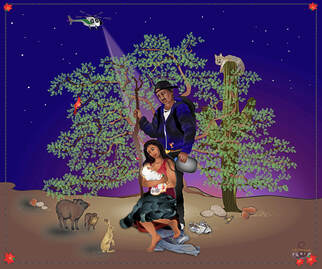
Arizona has been called "America's Meth Lab of Democracy". Many hot button issues were tried here first and have since gone national-- on steroids. One of them is Nativism. Back in 2013, I did a painting called, Navidad Baja Arizona - A Christmas Story. It was my response to the dehumanization of immigrants dying in our desert, and how women were accused of coming here to have "anchor babies" and game our system.
Fear and victim-blaming is a highly successful weapon as old as time and in Arizona, each generation breeds eager ears and new wrestless trigger fingers. Enter the Trump brand of Nativism and by 2019, it's a whole new ballgame. This Christmas, I didn't need to reinvent the wheel. I merely deported the Holy Couple, placing them in a Mexican border camp surveilled by ruthless realities. I want to offer up the idea that the Nativity is really about the persistence of the Human Spirit. Regimes come and go. Although ephemeral, the human spirit finds a way. Always.
- Linda Magdalena Victoria
Fear and victim-blaming is a highly successful weapon as old as time and in Arizona, each generation breeds eager ears and new wrestless trigger fingers. Enter the Trump brand of Nativism and by 2019, it's a whole new ballgame. This Christmas, I didn't need to reinvent the wheel. I merely deported the Holy Couple, placing them in a Mexican border camp surveilled by ruthless realities. I want to offer up the idea that the Nativity is really about the persistence of the Human Spirit. Regimes come and go. Although ephemeral, the human spirit finds a way. Always.
- Linda Magdalena Victoria
An homenaje to all things wondrous and wild this time of year in our corner of the world --loosely inspired by the folktale of the disobedient young lady seduced by the devil at a community dance. Here, the Lord Mictlán's appearance transcends the centuries. Adorning his skull face is the long hair of a warrior under a classic fedora hat. He is sporting a blood-red pachuco suit.
The backdrop is the iconic historical shrine, El Tiradito (The Castaway), often regarded as the heartbeat of Tucson, decorated for El Dia de los Muertos. It is meant to be a dance of male and female magnetism as one of the many primal energies associated with this time of year.
Ancient Aztec gods and goddesses rule the moon, pulling the two closer in their embrace. La Virgen de Guadalupe too, looks on -- gtom a ball cap that could have been left by a thankful border-crosser. Nuestra Señora is everywhere all the time here in the Borderlands.
As an afterthought, I added a curious little dog, following the couple's trail of marigold petals.
The backdrop is the iconic historical shrine, El Tiradito (The Castaway), often regarded as the heartbeat of Tucson, decorated for El Dia de los Muertos. It is meant to be a dance of male and female magnetism as one of the many primal energies associated with this time of year.
Ancient Aztec gods and goddesses rule the moon, pulling the two closer in their embrace. La Virgen de Guadalupe too, looks on -- gtom a ball cap that could have been left by a thankful border-crosser. Nuestra Señora is everywhere all the time here in the Borderlands.
As an afterthought, I added a curious little dog, following the couple's trail of marigold petals.
A fresh look at La Llorona - the Weeping Woman
The Legend of La Llorona is one of the oldest in the Americas, and there are countless versions of her legend but HERE is a good place to start. Most Latino kids know her as the witch their Mamas warn them about that lives in the arroyos looking for wayward children to eat. The larger legend is the one that she is the eternally damned murderous woman archetype that females the world over labor under.
The interpretation that resonates with me is the one by Mexican Nobel prize-winner, Octavio Paz. In his 1950 essay, The Labyrinth of Solitude, Paz describes La Llorona as one of the Mexican representations of Maternity and, as such, she is presented as a symbol of Mexican identity. This identity revolves around Mexicans’ view of themselves as "hijos de la Chingada". Paz explains that "the verb chingar denotes violence, an emergence from oneself to penetrate another by force … La Chingada is the Mother forcibly opened, violated or deceived. The Hijo de La Chingada is the offspring of violation, abduction or deceit."
This violation is the Conquest -- the quintessential symbol of which is La Malinche, or Doña Marina-- who, despite having been sold as a slave to Hernan Cortes because of her linguistic skills as a translator, has been painted as a traitor to ‘her people’. This archaic, misogynistic view that lays the blame for the defeat of a civilization at the feet of one disenfranchised woman has remained popular to this day. Indeed, Paz himself states that "the Mexican people have not forgiven La Malinche for her betrayal."
La Malinche and La Llorona become one after the former is chosen, used as chattel, then cast out along with her undesirable children. Honestly: what options do the untold millions of modern-day pariahs like La Malinche/La Llorona and their children have?
She carries it all... for all of us.
The interpretation that resonates with me is the one by Mexican Nobel prize-winner, Octavio Paz. In his 1950 essay, The Labyrinth of Solitude, Paz describes La Llorona as one of the Mexican representations of Maternity and, as such, she is presented as a symbol of Mexican identity. This identity revolves around Mexicans’ view of themselves as "hijos de la Chingada". Paz explains that "the verb chingar denotes violence, an emergence from oneself to penetrate another by force … La Chingada is the Mother forcibly opened, violated or deceived. The Hijo de La Chingada is the offspring of violation, abduction or deceit."
This violation is the Conquest -- the quintessential symbol of which is La Malinche, or Doña Marina-- who, despite having been sold as a slave to Hernan Cortes because of her linguistic skills as a translator, has been painted as a traitor to ‘her people’. This archaic, misogynistic view that lays the blame for the defeat of a civilization at the feet of one disenfranchised woman has remained popular to this day. Indeed, Paz himself states that "the Mexican people have not forgiven La Malinche for her betrayal."
La Malinche and La Llorona become one after the former is chosen, used as chattel, then cast out along with her undesirable children. Honestly: what options do the untold millions of modern-day pariahs like La Malinche/La Llorona and their children have?
She carries it all... for all of us.
My interpretation brings a little redemption to this, just one of the many maligned female archetypes in global mythologies.
I place La Llorona along the Santa Cruz River, somewhere south of Tubac. She is framed by mesquite trees and and has lost most of her hair. Her hand has delicate fingers rather than long, gruesome claws. And she is terribly, terribly weary. She is surrounded by a troop of Monarch butterflies on their way to their winter roost in Mexico. They are spirits of children who visit her every year to comfort her on their journey south. I put tiny eyes on the butterflies and colorful spots on their bodies to make them special. I always incorporate owls into my paintings where the veil between the worlds are thin. It is a guardian keeping watch over the ephemeral scene. Owls are sacred birds in many cultures and I adore them.
I include also my signature petroglyph boulder alluding to the timelessness of the land.
I place La Llorona along the Santa Cruz River, somewhere south of Tubac. She is framed by mesquite trees and and has lost most of her hair. Her hand has delicate fingers rather than long, gruesome claws. And she is terribly, terribly weary. She is surrounded by a troop of Monarch butterflies on their way to their winter roost in Mexico. They are spirits of children who visit her every year to comfort her on their journey south. I put tiny eyes on the butterflies and colorful spots on their bodies to make them special. I always incorporate owls into my paintings where the veil between the worlds are thin. It is a guardian keeping watch over the ephemeral scene. Owls are sacred birds in many cultures and I adore them.
I include also my signature petroglyph boulder alluding to the timelessness of the land.
This may be the last in my series honoring asylum seekers for a while. It is an intimate capture of the bond between parent and child. I so loved the ancient classic Maya bone structure of the mother's face... timeless beauty. I wonder if they are still alive-- and together. Our administration will go down in history for crimes against humanity.
I must say here that the brutal saga of America's asylum seekers hit a nerve. When reports revealed what "Zero-Tolerance" was doing to families, children, even babies, I'd had enough.
I was determined to do something. I saw my niche when the plumbing collapsed at the old Benedictine Monastery, Tucson's primary migrant shelter. A dozen porta-johns were brought in and volunteers built outdoor showers with garden hoses, PVC pipes, pallets, tarps. I and a lovely Catholic lady cleaned all of them daily, and continued to do so until the Casa Alitas Program relocated to their new facility farther south. The refugees were conscientious and always offering to help. The physical stresses they had suffered were evident in what I cleaned, and it was heart-wrenching. These are the ones we depend on to clean OUR toilets and who tirelessly devote themselves to our worst jobs, in the shadows, so that we Americans can have a better life. There were days it was so overwhelming I'd dissolve in my car before I could leave.
I felt a need to lift up the humanity of these remarkable "throw-away" people who had suffered so much and come so far. That need gave birth to this series of artworks.
I must say here that the brutal saga of America's asylum seekers hit a nerve. When reports revealed what "Zero-Tolerance" was doing to families, children, even babies, I'd had enough.
I was determined to do something. I saw my niche when the plumbing collapsed at the old Benedictine Monastery, Tucson's primary migrant shelter. A dozen porta-johns were brought in and volunteers built outdoor showers with garden hoses, PVC pipes, pallets, tarps. I and a lovely Catholic lady cleaned all of them daily, and continued to do so until the Casa Alitas Program relocated to their new facility farther south. The refugees were conscientious and always offering to help. The physical stresses they had suffered were evident in what I cleaned, and it was heart-wrenching. These are the ones we depend on to clean OUR toilets and who tirelessly devote themselves to our worst jobs, in the shadows, so that we Americans can have a better life. There were days it was so overwhelming I'd dissolve in my car before I could leave.
I felt a need to lift up the humanity of these remarkable "throw-away" people who had suffered so much and come so far. That need gave birth to this series of artworks.
This may be my favorite image of border-crossers. I wanted to paint this couple because I think they are utterly captivating. It's not a new image and has been hanging around on my computer for years. I pray they are both doing well.
Via the photographer:
"Flor Garcia, 19, of Honduras, holding her one-year-old daughter, Flor Fernandez turned themselves over to CBP after crossing the Rio Grande from Mexico near McAllen, Texas, on Thursday, July 3, 2014."
Photo: Rodolfo Gonzalez/AP
Via the photographer:
"Flor Garcia, 19, of Honduras, holding her one-year-old daughter, Flor Fernandez turned themselves over to CBP after crossing the Rio Grande from Mexico near McAllen, Texas, on Thursday, July 3, 2014."
Photo: Rodolfo Gonzalez/AP
The twelfth soul in my En Memoriam project honoring asylum seekers who did not survive the rigors of the American border (and hopefully my last, at least for a while):
Darlyn Cristabel Cordova-Valle, Age 10
Of El Salvador
Died Sept. 29, 2018 of heart complications,
Nebraska
Darlyn was encountered by Border Patrol on March 1, 2018, a few miles west of Hidalgo, Texas. She complained of chest pain and three days later, was transferred to HHS custody where she remained for about seven months. Darlyn was treated for a congenital heart defect at various hospitals -- including in San Antonio, Texas and Phoenix, Arizona.
HHS spokesperson Mark Weber told CNN Darlyn had surgery complications that left her in a comatose state. She was transported to a nursing facility in Phoenix and later to Children's Hospital in Omaha, Nebraska, where she died on September 29, due to fever and respiratory distress.
Darlyn was traveling to the US to find her mom, who had migrated from El Salvador to work and provide for her three daughters nine years earlier. She hoped to be reunited with her mother in Nebraska. Her mother asked that Darlyn be released to her care. The government refused.
Her body was returned to El Salvador.
Darlyn's story HERE.
HHS spokesperson Mark Weber told CNN Darlyn had surgery complications that left her in a comatose state. She was transported to a nursing facility in Phoenix and later to Children's Hospital in Omaha, Nebraska, where she died on September 29, due to fever and respiratory distress.
Darlyn was traveling to the US to find her mom, who had migrated from El Salvador to work and provide for her three daughters nine years earlier. She hoped to be reunited with her mother in Nebraska. Her mother asked that Darlyn be released to her care. The government refused.
Her body was returned to El Salvador.
Darlyn's story HERE.
The eleventh soul in my En Memoriam project honoring asylum seekers who did not survive the rigors of the American border:
Claudia Patricia Gómez González, Age 20
of San Juan Ostuncalco, Guatemala
Shot by BP agent, May 24, 2018
Rio Bravo, TX
of San Juan Ostuncalco, Guatemala
Shot by BP agent, May 24, 2018
Rio Bravo, TX
Claudia earned a degree in accounting but had not been able to find a job in her home country of Guatemala, so she traveled 1,500 miles to the United States, hoping to find a job and a better future. Shortly after she set foot in Texas, a Border Patrol agent shot her in the head and killed her.
Gomez-Gonzalez's shooting drew international attention after a bystander posted video of the aftermath on Facebook Live, showing her lying on the ground, bleeding. Authorities changed their initial account of the shooting two days later, adding to the controversy at a time when the White House has cracked down on undocumented immigrants.
The deadly encounter ended the journey Gomez-Gonzalez started nearly three weeks before in an indigenous community in San Juan Ostuncalco, Guatemala.
The details around the death of this young Guatemalan woman remain unresolved, as the majority of migrant deaths are. And like many others, a wrongful death suit against CBP on her behalf was filed, a year after her death.
Claudia's story HERE.
Gomez-Gonzalez's shooting drew international attention after a bystander posted video of the aftermath on Facebook Live, showing her lying on the ground, bleeding. Authorities changed their initial account of the shooting two days later, adding to the controversy at a time when the White House has cracked down on undocumented immigrants.
The deadly encounter ended the journey Gomez-Gonzalez started nearly three weeks before in an indigenous community in San Juan Ostuncalco, Guatemala.
The details around the death of this young Guatemalan woman remain unresolved, as the majority of migrant deaths are. And like many others, a wrongful death suit against CBP on her behalf was filed, a year after her death.
Claudia's story HERE.
The tenth soul in my En Memoriam project honoring asylum seekers who did not survive the rigors of the American border.
Johana Medina-León, Age 25
of El Salvador
Died June 1, 2019
Texas
of El Salvador
Died June 1, 2019
Texas
Medina's journey to the U.S. had taken months. She had waited for a Mexican transitory visa for more than a month in Tapachula, Chiapas, near the Guatemalan border, Diversidad Sin Fronteras stated. The advocacy group said Medina waited nearly three months in Juárez before she was allowed to make her asylum claim to U.S. immigration officials in El Paso.
Johana known to friends as "Joa," died at the Del Sol Medical Center in El Paso, Texas, after being detained by US Immigration and Customs Enforcement for seven weeks. Medina had been a certified nurse in El Salvador but sought asylum in the U.S. because she couldn't work as an open trans woman in the nursing profession in her home country. From April 11 to about May 23, her health deteriorated and she tested positive for HIV. She begged for medical attention that never came.
In mid-May, she had passed her "credible fear" interview, which determined she would be persecuted if she returned to El Salvador, but Leon wasn't paroled until she began complaining of chest pains and was taken to Del Sol Medical Center. She passed away four days later.
Johana's story HERE.
Johana known to friends as "Joa," died at the Del Sol Medical Center in El Paso, Texas, after being detained by US Immigration and Customs Enforcement for seven weeks. Medina had been a certified nurse in El Salvador but sought asylum in the U.S. because she couldn't work as an open trans woman in the nursing profession in her home country. From April 11 to about May 23, her health deteriorated and she tested positive for HIV. She begged for medical attention that never came.
In mid-May, she had passed her "credible fear" interview, which determined she would be persecuted if she returned to El Salvador, but Leon wasn't paroled until she began complaining of chest pains and was taken to Del Sol Medical Center. She passed away four days later.
Johana's story HERE.
The ninth soul in my En Memoriam project honoring asylum seekers who did not survive the rigors of the American border.
Juan de León Gutiérrez, Age 16
of Guatemala
Died April 30, 2019
Texas
of Guatemala
Died April 30, 2019
Texas
After 2 years of drought, Juan left an area of Guatemala where children are known to be stunted by malnutrition. He hoped to be reunited with his brother in Miami.
Juan was apprehended by U.S. Border Patrol near El Paso after crossing the U.S.-Mexico border. He was transferred to a local hospital after a doctor at a government shelter noticed he was sick. He was released and hospitalized again a day later. Juan was 16 years old when he died of a brain infection.
His family had no money--not even to take the bus to Guatemala City where an airplane carrying his body would arrive.
More of Juan's story HERE.
Juan was apprehended by U.S. Border Patrol near El Paso after crossing the U.S.-Mexico border. He was transferred to a local hospital after a doctor at a government shelter noticed he was sick. He was released and hospitalized again a day later. Juan was 16 years old when he died of a brain infection.
His family had no money--not even to take the bus to Guatemala City where an airplane carrying his body would arrive.
More of Juan's story HERE.
The eighth soul in my En Memoriam project honoring asylum seekers who did not survive the rigors of the American border.
Carlos Gregorio Hernandez-Vasquez, Age 16
from Guatemala
Died May 20, 2019,
Texas
from Guatemala
Died May 20, 2019,
Texas
Carlos died in Border Patrol custody while trying to reunite with family members in the United States. He was also venturing north to support his siblings, one of whom is disabled. 1 of 9 children from an area of extreme poverty in the Guatemalan Highlands, he was a soccer player, a musician who played bass and piano, and a healthy young man, his family told a Guatemalan television station.
Hernandez succumbed to the flu, complicated by pneumonia and sepsis, on or near the toilet of his South Texas Border Patrol cell. His body was returned to Guatemala.
More of Carlos' story HERE.
Hernandez succumbed to the flu, complicated by pneumonia and sepsis, on or near the toilet of his South Texas Border Patrol cell. His body was returned to Guatemala.
More of Carlos' story HERE.
New Report Shows “Deeply Troubling Failures” by Border Patrol in Boy’s Death, Key Congressional Leader Says
ProPublica, Sept. 17, 2021
ProPublica, Sept. 17, 2021

Inside the Cell Where a Sick 16-Year-Old Boy Died in Border Patrol Care
ProPublica, Dec. 5, 2019
ProPublica, Dec. 5, 2019
The seventh soul in my En Memoriam project honoring asylum seekers who did not survive the rigors of the American border.
Wilmer Josué Ramírez Vázquez, Age 2
of Guatemala
Died May 14, 2019, Texas
of Guatemala
Died May 14, 2019, Texas
Wilmer's mother brought him to the U.S. to get him medical care for a condition that left him unable to walk. Wilmer and his mother Hilda left home in March to make the journey to the U.S. He became ill in Mexico and crossed into the United States with a high fever and difficulty breathing. Diagnosed with pneumonia and other complications at a children's hospital, Wilmer died about a month later.
Wilmer's story HERE.
Wilmer's story HERE.
The sixth soul in my En Memoriam project honoring asylum seekers who did not survive the rigors of the American border.
Roxsana Hernandez-Rodriguez, Age 33
of Honduras
Died May 30, 2018, New Mexico
of Honduras
Died May 30, 2018, New Mexico
Roxsana said she had fled Honduras in part because of the discrimination and violence she faced for being transgender. (She was gang-raped by four MS-13 members and contracted HIV. ) She said in an interview, "Trans people in my neighborhood are killed and chopped into pieces, then dumped inside potato bags."
Hernandez was one of roughly 25 transgender and gender-nonconforming individuals who joined the annual caravan of Central American migrants heading to the US border. She crossed at the San Ysidro Port of Entry near San Diego and was later transferred to a CPB facility in NM for transgender detainees. She succumbed to symptoms of pneumonia, severe dehydration, and complications associated with HIV and later died from cardiac arrest.
Roxsana's story HERE.
Hernandez was one of roughly 25 transgender and gender-nonconforming individuals who joined the annual caravan of Central American migrants heading to the US border. She crossed at the San Ysidro Port of Entry near San Diego and was later transferred to a CPB facility in NM for transgender detainees. She succumbed to symptoms of pneumonia, severe dehydration, and complications associated with HIV and later died from cardiac arrest.
Roxsana's story HERE.
The fourth & fifth souls in my En Memoriam project honoring asylum seekers who did not survive the rigors of the American border.
Óscar Alberto Martínez-Ramírez, 25 yrs.
Angie Valeria, 23 mos.
both of El Salvador
Drowned together in the Rio Grande River, June 24, 2019
Angie Valeria, 23 mos.
both of El Salvador
Drowned together in the Rio Grande River, June 24, 2019
Working at a pizzeria in El Salvador, Óscar made approximately $350 a month supporting his wife Tania Vanessa Ávalos, and their young daughter, Valeria. The three lived with his mother, Rosa Ramírez, in a two-bedroom home outside of San Salvador. She gave them the larger room, but they wanted more than a life on $10 a day.
Frustrated at being unable to present themselves to U.S. authorities and request asylum, Oscar swam across the river with his daughter. He set her on the U.S. bank of the river and started back for his wife, but seeing him move away the girl threw herself into the waters. Óscar returned and was able to grab Valeria, but the current then swept them both away.
Oscar & Valeria's story HERE.
Frustrated at being unable to present themselves to U.S. authorities and request asylum, Oscar swam across the river with his daughter. He set her on the U.S. bank of the river and started back for his wife, but seeing him move away the girl threw herself into the waters. Óscar returned and was able to grab Valeria, but the current then swept them both away.
Oscar & Valeria's story HERE.
The third soul in my En Memoriam project honoring asylum seekers who did not survive the rigors of the American border.
Mariee Juarez of Guatemala
Age: 19 mos.
Died May 10, 2018, New Jersey
(after being held at ICE detention in Dilley, TX)
Age: 19 mos.
Died May 10, 2018, New Jersey
(after being held at ICE detention in Dilley, TX)
After experiencing inhospitable violence in her home country, Mariee's mother, Yazmin Juárez, was faced with the difficult choice of staying in Guatemala and likely facing death or fleeing to the United States to apply for asylum. The decision to embark on such a journey was a remarkably dangerous one with no guarantee of obtaining legal status in the end, but as Yazmin recounted, the crushing instability of their home country made staying put impossible.
When the two arrived at the border in Texas, they were quickly funneled into the U.S. immigrant detention system to wait for their case to be processed. They were both examined by a doctor and found to be healthy. The two were then transferred to a facility in Dilley, Texas where they were crammed into a filthy, crowded cell with sick children. Mariee became sick within a week of their detention with a cough and runny nose and grew steadily worse; contracting a high fever and diarrhea and vomiting.
Yazmin stood in line for hours, begging the guards for help. When Mariee was finally seen, she was given antibiotics after a quick examination. Yazmin begged the clinicians to run additional tests and allow her daughter to stay in a more sanitary area until she recovered, but she was sent back into their overcrowded cell with the other sick children.
Shortly thereafter, the two were released from custody and allowed to stay with family in New Jersey until their asylum claim could be heard in court. Upon their arrival, Juárez rushed her daughter to the hospital where it became clear that her condition was far worse than diagnosed. Mariee died six weeks later, on the day celebrated as Mother’s Day in Guatemala.
Mariee and Yazmin's full story HERE.
When the two arrived at the border in Texas, they were quickly funneled into the U.S. immigrant detention system to wait for their case to be processed. They were both examined by a doctor and found to be healthy. The two were then transferred to a facility in Dilley, Texas where they were crammed into a filthy, crowded cell with sick children. Mariee became sick within a week of their detention with a cough and runny nose and grew steadily worse; contracting a high fever and diarrhea and vomiting.
Yazmin stood in line for hours, begging the guards for help. When Mariee was finally seen, she was given antibiotics after a quick examination. Yazmin begged the clinicians to run additional tests and allow her daughter to stay in a more sanitary area until she recovered, but she was sent back into their overcrowded cell with the other sick children.
Shortly thereafter, the two were released from custody and allowed to stay with family in New Jersey until their asylum claim could be heard in court. Upon their arrival, Juárez rushed her daughter to the hospital where it became clear that her condition was far worse than diagnosed. Mariee died six weeks later, on the day celebrated as Mother’s Day in Guatemala.
Mariee and Yazmin's full story HERE.
The second soul in my En Memoriam project honoring asylum seekers who did not survive the rigors of the American border.
Felipe Alonzo Gomez, Age 8,
of Guatemala.
Died Dec. 24, 2018, New Mexico
of Guatemala.
Died Dec. 24, 2018, New Mexico
Felipe was excited to come to America. His father, Augustin, thought taking Felipe to the U.S. would give him more “opportunity,” and was focused on escaping the poverty of their hometown. Felipe hoped to have his own bicycle.
The boy’s mother, Catarina Alonzo Perez, said she spoke with her son the day before they arrived at the U.S. border. “He wasn’t sick on the way; he wasn’t sick here,” she said through her stepdaughter in the Mayan language known as Chuj.
His body was returned to Guatemala.
More of Felipe's story HERE.
The boy’s mother, Catarina Alonzo Perez, said she spoke with her son the day before they arrived at the U.S. border. “He wasn’t sick on the way; he wasn’t sick here,” she said through her stepdaughter in the Mayan language known as Chuj.
His body was returned to Guatemala.
More of Felipe's story HERE.
The first soul in my En Memoriam project honoring asylum seekers who did not survive the rigors of the American border.
Jakelin Amei Rosmery Caal-Maquin, age 7
of Raxruha, Guatemala.
Died Dec. 8, 2018, in New Mexico.
of Raxruha, Guatemala.
Died Dec. 8, 2018, in New Mexico.
She and her father traveled 3,000 miles from Guatemala seeking a better life. She jumped when her father told her she could come with him to the U.S. She thought she might get her first toy, or learn to write. She got her first pair of shoes right before the trip. They were apprehended the night of Dec. 6 at the extremely remote port of entry at Antelope Wells, New Mexico, by Border Patrol agents, just 2 days before she died. Jakelin died of sepsis.
Jakelin's story HERE.
Jakelin's story HERE.
As told by Clarissa Pinkola Estés, PhD, Women Who Run With the Wolves:
"There is an old woman who lives in a hidden place that everyone knows but few have seen. As in the fairy tales of Eastern Europe, she seems to wait for lost or wandering people and seekers to come to her place.
She is circumspect, often hairy, always fat, and especially wishes to evade most company. She is both a crower and a cackler, generally having more animal sounds than than human ones.
They say she lives among the rotten granite slopes in Tarahumara Indian territory. They say she is buried outside Phoenix near a well. She is said to have been traveling south to Monte Alban in a burnt out car with the back window shot out. She is said to stand by the highway near El Paso, or ride shotgun with truckers to Morelia, Mexico, or that she has been sighted walking to to market above Oaxaca with strangely formed boughs of firewood on her back. She is called by many names: La Huesera, Bone Woman, La Trapera, The Gatherer, and La Loba, Wolf Woman.
"There is an old woman who lives in a hidden place that everyone knows but few have seen. As in the fairy tales of Eastern Europe, she seems to wait for lost or wandering people and seekers to come to her place.
She is circumspect, often hairy, always fat, and especially wishes to evade most company. She is both a crower and a cackler, generally having more animal sounds than than human ones.
They say she lives among the rotten granite slopes in Tarahumara Indian territory. They say she is buried outside Phoenix near a well. She is said to have been traveling south to Monte Alban in a burnt out car with the back window shot out. She is said to stand by the highway near El Paso, or ride shotgun with truckers to Morelia, Mexico, or that she has been sighted walking to to market above Oaxaca with strangely formed boughs of firewood on her back. She is called by many names: La Huesera, Bone Woman, La Trapera, The Gatherer, and La Loba, Wolf Woman.
The sole work of La Loba is the collecting of bones. She is known to collect and preserve especially that which is in danger of being lost to the world. Her cave is filled with the bones of all manner of desert creatures: the deer, the rattlesnake, the crow. But her specialty is said to be wolves.
She creeps and crawls and sifts through the montañas, mountains, and arroyos, dry riverbeds, looking for wolf bones, and when she has assembled an entire skeleton, when the last bone is in place and the beautiful white sculpture of the creature is laid out before her, she sits by the fire and thinks about what song she will sing.
And when she is sure, she stands over the criatura, raises her arms over it, and sings out. That is when the the rib bones and leg bones of the wolf begin to flesh out and the creature becomes furred. La Loba sings some more, and more of the creature comes into being; its tail curls upward, shaggy and strong.
And still La Loba sings so deeply that the floor of the desert shakes, and as she sings, the wolf opens its eyes, leaps up, and runs away down the canyon.
And still La Loba sings so deeply that the floor of the desert shakes, and as she sings, the wolf opens its eyes, leaps up, and runs away down the canyon.
Somewhere in its running, whether by the speed of its running, or by splashing its way into a river, or by way of a ray of sunlight or moonlight hitting it right in the side, the wolf is suddenly transformed into a laughing woman who runs free towards the horizon.
So it is said that if you wander the desert, and it is near sundown, and you are perhaps a little bit lost, and certainly tired, that you are lucky, for La Loba may take a liking to you and show you something— something of the soul."
More from Dr. Clarissa Pinkola Estés : http://www.clarissapinkolaestes.com/works.htm
So it is said that if you wander the desert, and it is near sundown, and you are perhaps a little bit lost, and certainly tired, that you are lucky, for La Loba may take a liking to you and show you something— something of the soul."
More from Dr. Clarissa Pinkola Estés : http://www.clarissapinkolaestes.com/works.htm
La Loba speaks to me as the eternal seed of life that does not die. Ravaged by man and time - sorrowful, yet soft. The bumblebee on her hand is one my mother drew before she died and I like to honor her where I can in my paintings. Her fingertips bear the ancient indigenous spiral symbol.
A once majestic saguaro stands long-dead, with only shards of its skin remaining. It is pierced by multiple bullet holes - the fate common to many of today's living saguaros. The spiral emergence petroglyph on the boulder at its feet bears the same scars of human thoughtlessness. In the background is a rusted shell of a vintage automobile that La Loba uses as a repository for her collected bones. She burns a few twigs of holy wood in an abalone shell and sings her assembled skeleton into being. Hummingbirds, messengers of the spirit world, greet the awakening spirit of the wolf. La Loba may be returning the animal spirits to an ancient celestial home; evidenced by a blue star glowing in the distance.
A once majestic saguaro stands long-dead, with only shards of its skin remaining. It is pierced by multiple bullet holes - the fate common to many of today's living saguaros. The spiral emergence petroglyph on the boulder at its feet bears the same scars of human thoughtlessness. In the background is a rusted shell of a vintage automobile that La Loba uses as a repository for her collected bones. She burns a few twigs of holy wood in an abalone shell and sings her assembled skeleton into being. Hummingbirds, messengers of the spirit world, greet the awakening spirit of the wolf. La Loba may be returning the animal spirits to an ancient celestial home; evidenced by a blue star glowing in the distance.
Lotería de Tucson 2018 was an exhibition featuring mixed media creations about Greater Tucson by 54 Arizona artists. The original works of art were photographed and published to comprise a deck of Lotería cards. Sales proceeds of the card decks benefit the Community Food Bank of Southern Arizona.
The box design is my interpretation of some of the things that make me proud to be a Tucsonense.
The box design is my interpretation of some of the things that make me proud to be a Tucsonense.
Just found this old colored pencil drawing of a young aboriginal woman. I drew her some years ago from a tiny photo in a NatGeo magazine. I don't know what tribal culture she is part of, but I thought her face was captivating.
I always enjoy creating art for my friends Kevin & James at Arte de La Vida... This fall, they are featuring works by local artists honoring the spirits of deceased pets. The art featured on the card is called "Into My Dreams Tonight", by Robin West.
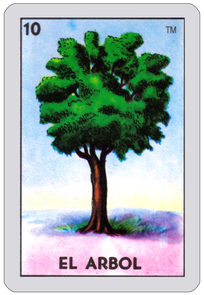
This piece is fashioned after one of the 10th card in Mexico's national game, ¡Lotería!. The Mexican version of the card is simple (right), and has a companion dicho (saying):
El que a buen árbol se arrima, buena sombra le cobija.
(He who nears a good tree, is blanketed by good shade.)
However, I don't do anything simple, so I expanded my interpretation to symbolize a Tree of Life. I found inspiration from the fabulous yarn painting of the Huichol Indians of Mexico's Sierra Madre Occidental, and "painted" with my computer mouse as if I was working with yarn. The paintings are all-digital, created using the software program, Adobe Illustrator.
The concept of a tree of life is a widespread archetype in the world's mythologies; a sacred tree in religious and philosophical tradition. The tree of knowledge, connecting to heaven and the underworld, and the tree of life, connecting all forms of creation, are both forms of the world tree or cosmic tree. My interpretation is one akin to connecting all forms of creation, and I include animals & insects found in our Sonoran corner of the world: the bat, bees, hummingbirds, the cardinal, the jaguar, sky-island squirrel, a pair of deer, the owl*, and of course, the mythical serpent, La Corua.
* The pinwheel design on the owl's breast is that of a peyote cactus bud - the spiritual hub of Huichol culture.
El que a buen árbol se arrima, buena sombra le cobija.
(He who nears a good tree, is blanketed by good shade.)
However, I don't do anything simple, so I expanded my interpretation to symbolize a Tree of Life. I found inspiration from the fabulous yarn painting of the Huichol Indians of Mexico's Sierra Madre Occidental, and "painted" with my computer mouse as if I was working with yarn. The paintings are all-digital, created using the software program, Adobe Illustrator.
The concept of a tree of life is a widespread archetype in the world's mythologies; a sacred tree in religious and philosophical tradition. The tree of knowledge, connecting to heaven and the underworld, and the tree of life, connecting all forms of creation, are both forms of the world tree or cosmic tree. My interpretation is one akin to connecting all forms of creation, and I include animals & insects found in our Sonoran corner of the world: the bat, bees, hummingbirds, the cardinal, the jaguar, sky-island squirrel, a pair of deer, the owl*, and of course, the mythical serpent, La Corua.
* The pinwheel design on the owl's breast is that of a peyote cactus bud - the spiritual hub of Huichol culture.
